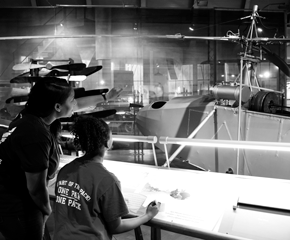Making the Connection: Phoning on the Go
When telephones were first introduced in the late 1800s, people wanting a phone would subscribe to the local phone company’s services and receive a telephone on lease. Using the telephone at this time meant that both caller and receiver were tethered to their respective locations. But as American life became more bustling and more people found themselves away from home for greater portions of their day, telephone technology adapted.
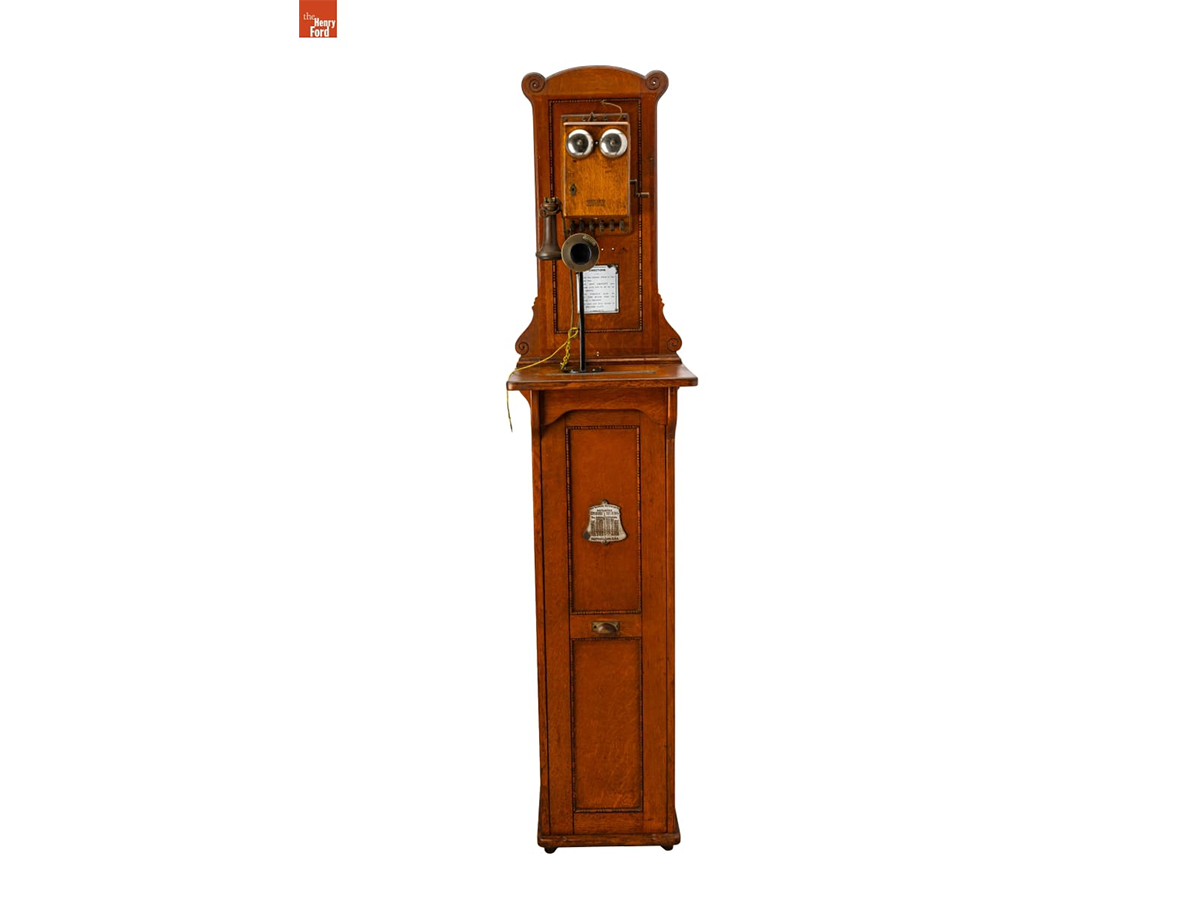 Pay telephone featuring patents by William Gray, circa 1898 / THF805358
Pay telephone featuring patents by William Gray, circa 1898 / THF805358
In 1889, the first public, coin-operated pay telephone was installed in Hartford, Connecticut, at the Hartford Connecticut Trust Company. The device had been conceived of and patented by William Gray; according to legend, he was inspired by his inability to find a publicly available phone when his wife was ill and needed a doctor. The pay telephone worked by creating slots for different denominations of coins, and different chimes or bells would sound as the money was deposited. Once the right amount had been deposited—the operator could tell by the chimes—the call would be put through. The Gray Telephone Pay Station Company, founded by Gray in 1891, would go on to install pay telephones across the country and refine their designs, creating different models for different needs and locations, from city streets to hotel lobbies. The company would be incredibly successful, even surviving the Great Depression before being bought out by Automatic Electric in 1948.
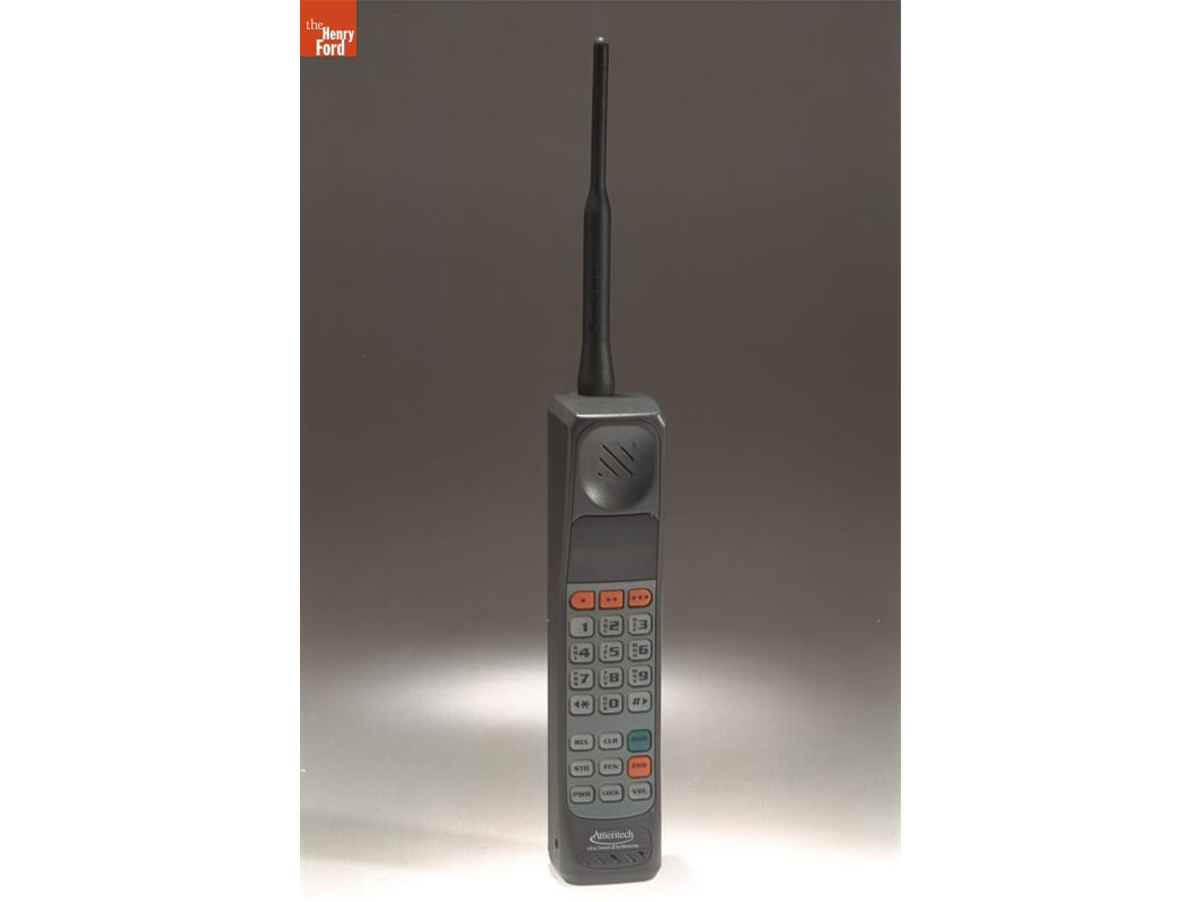 Motorola Brick Phone, 1985 / THF97588
Motorola Brick Phone, 1985 / THF97588
On April 3, 1973, Motorola engineer Martin Cooper made the first publicized cell phone call—to Joel Engel, who was working at AT&T trying to develop the same technology, which would allow users to make calls without having a physical connection to a network, unlike previous phones. While the car phone—a device that was mounted in the trunk of a car, with cables running through the vehicle to connect to a headset in the cabin—already existed and allowed for some mobile communication, its adoption was intentionally limited by the Federal Communications Commission (FCC), which required licenses for its use. Motorola continued refining their cellphone technology, and in 1983 they had the first commercially available cellphone ready for the market. By 1990, over one million Americans were using cellphones.
Pay phones and mobile phones help people get in touch on the go. But what about when the recipient, not necessarily the caller, is out and about? For that, we turned to different technologies—including the answering machine and the pager.
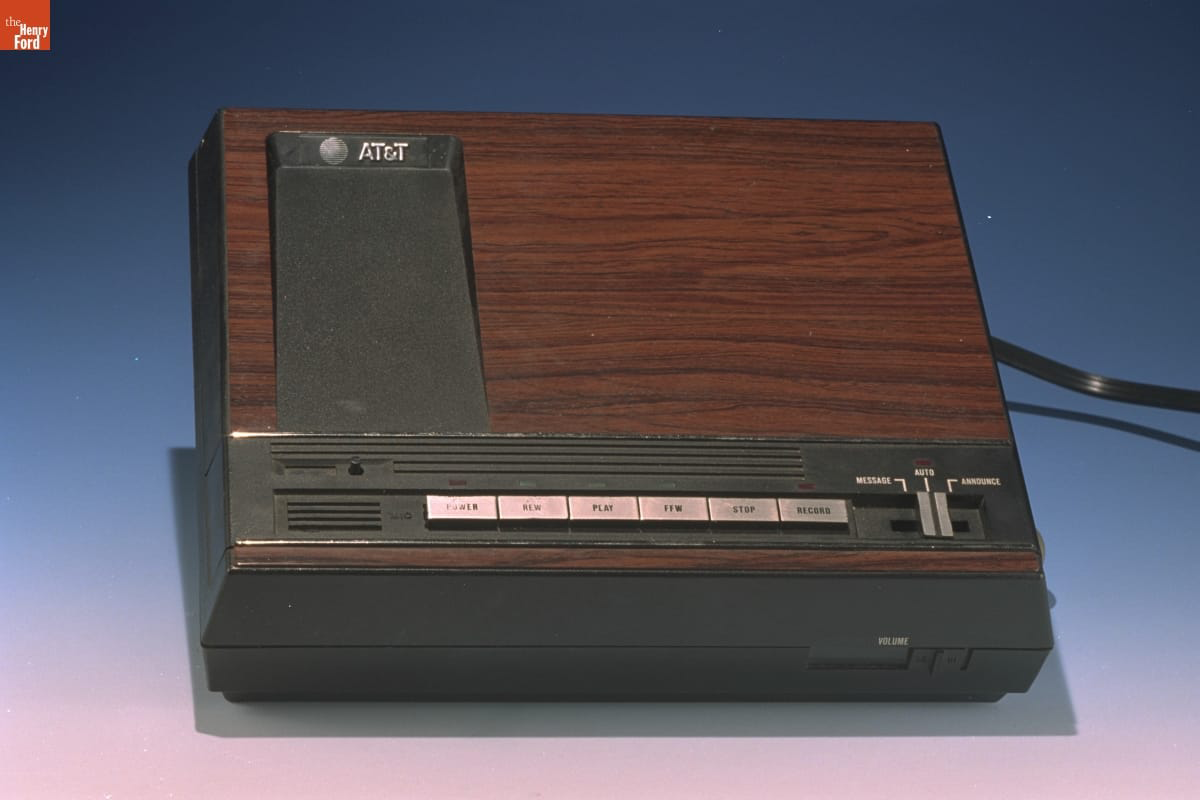 AT&T Model 2100 Telephone Answering Machine, circa 1983 / THF323526
AT&T Model 2100 Telephone Answering Machine, circa 1983 / THF323526
Although the first automatic answering machine was invented in 1935, the first commercially viable machine didn’t arrive until 1971, with PhoneMate’s Model 400. By the end of the 1980s, one in three American households owned an answering machine. While the concept may seem simple, the implications for telephone culture were immense. Now there was a way to be continuously available; even if you were away from your telephone, the machine would make sure that the caller’s message was there waiting for you when you returned. The adoption of answering machines also led to a change in the culture around phone calls. On the one hand, calls were easier to screen, but on the other, a missed call no longer meant the onus was on the caller to try again, but rather on the recipient to phone back.
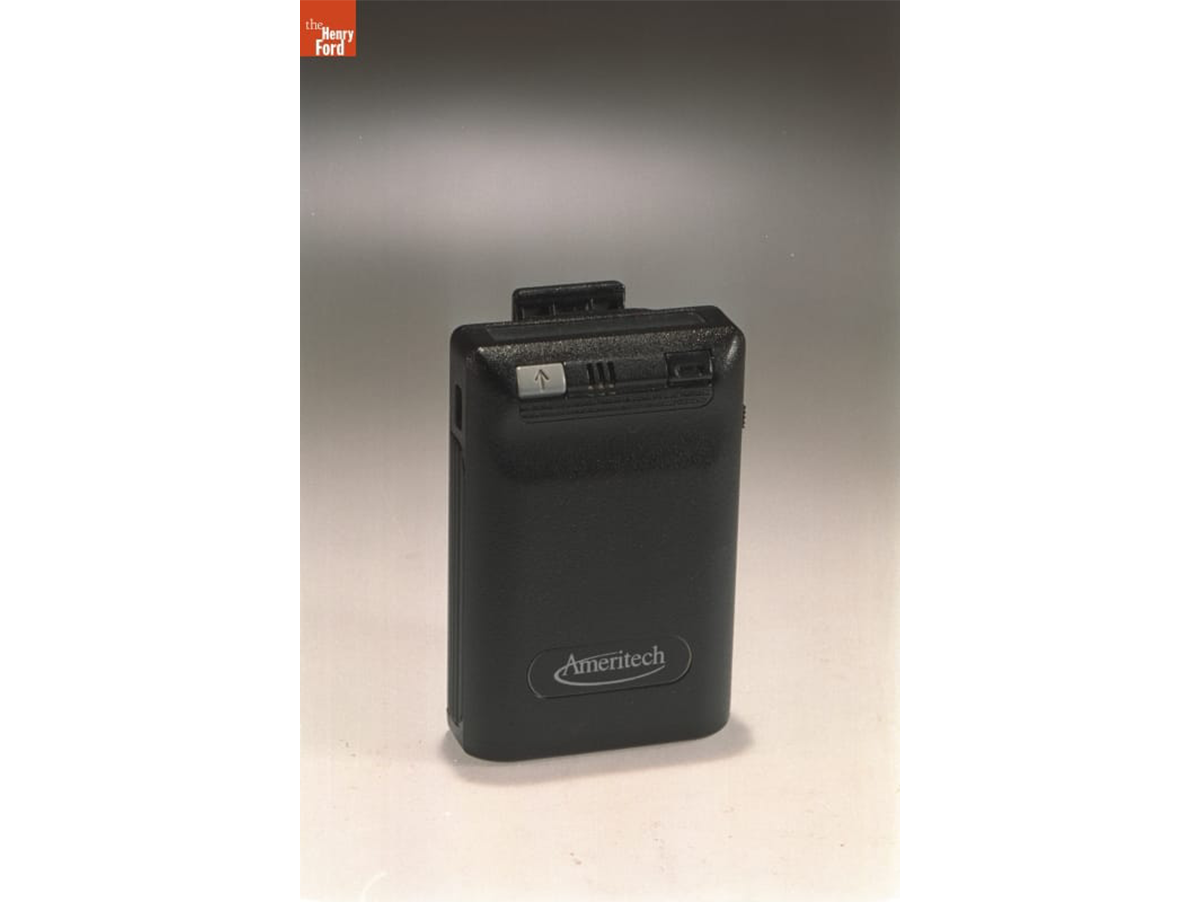 Motorola Pager, 1995 / THF302299
Motorola Pager, 1995 / THF302299
In 1949, wireless communication pioneer Al Gross patented the very first telephone paging device. The following year, the device was put into service at New York's Jewish Hospital—marking the start of what would be a long history of use in critical communications. In 1959, Motorola coined the term “pager,” and the name stuck; in 1964, they would become the main force in the pager market with the first versions available to consumers. While the first pagers delivered tone-only messages, by the 1980s new versions had been developed that displayed alpha-numeric messages, allowing people to send short messages without having to pick up a phone. By 1994, over 61 million pagers were in use. Although the rise of cell phones with the ability to send text messages led to pagers falling out of favor with the general public, pagers remain a crucial part of many hospitals' and first responders' communication systems.
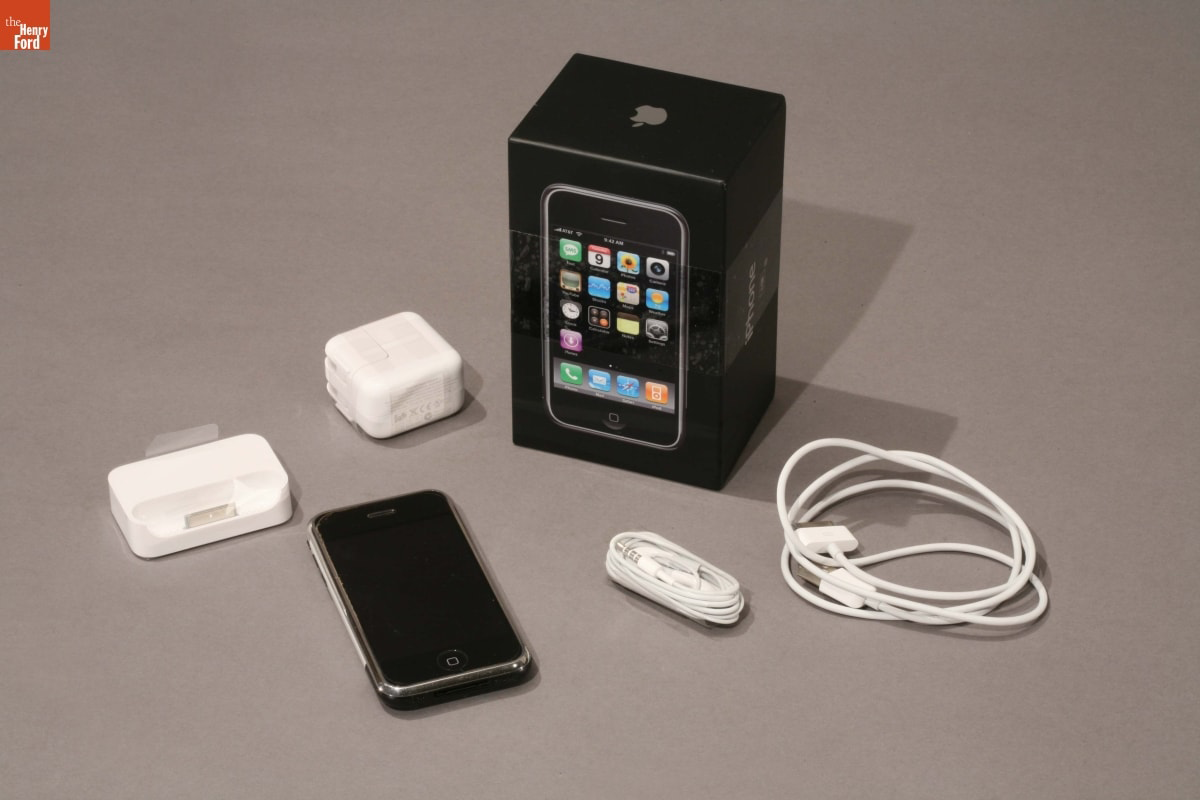 iPhone, 2007 / THF92290
iPhone, 2007 / THF92290
Of course, thanks to the smartphone, our telephone technology now solves more problems than ever before, all in a conveniently portable package. Landline telephones have waned in popularity, and for many of us, our mobile phone is now our only phone. We can text paragraphs of thoughts with a few swipes on a screen. Our phones not only automatically come with a voicemail function, but many of them will even transcribe the messages for us. We’re more reachable than ever before, yet many of us talk on the phone even less. The remnants of the technology that led to this moment still exist, though—just waiting for us to make the connection.
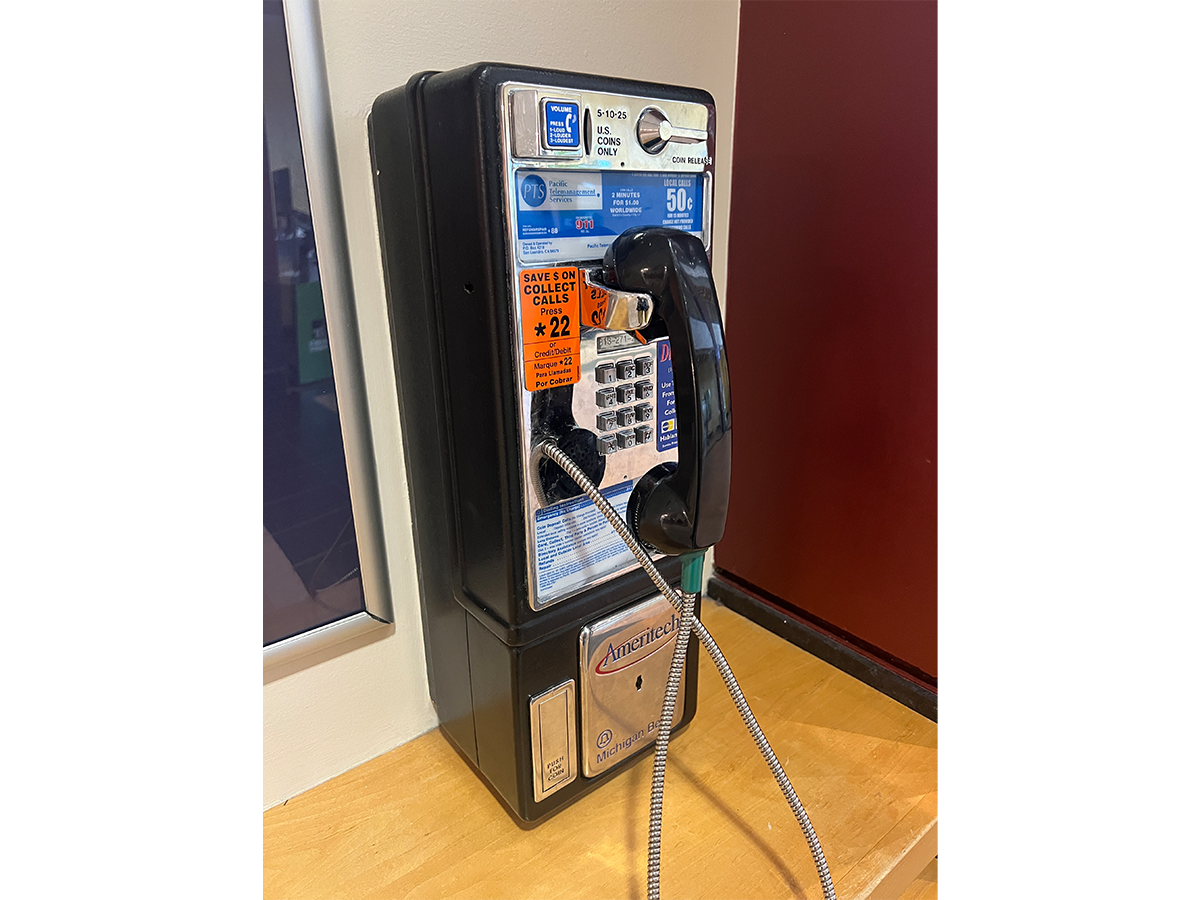 A functioning pay phone can still be found—and used!—in the Welcome Center at Henry Ford Museum of American Innovation. / Photo by Rachel Yerke-Osgood
A functioning pay phone can still be found—and used!—in the Welcome Center at Henry Ford Museum of American Innovation. / Photo by Rachel Yerke-Osgood
The Henry Ford's 1898 pay telephone was conserved, rehoused, and digitized thanks to a grant from the Institute of Museum and Library Servcies (IMLS).
Rachel Yerke-Osgood is an Associate Curator at The Henry Ford.
The Jackson Home—Unpacking a Family's Story
In the spring of 2023, the contents of an entire house—9,000 everyday objects, including photographs, documents, books, and household items—were logged, packed, and shipped from Selma, Alabama to Dearborn, Michigan. That house was the Jackson Family Home, which was recently moved to its new permanent home in Greenfield Village—you can find out more about the move here. The items arrived and staff started their work to introduce them into The Henry Ford's Collection.
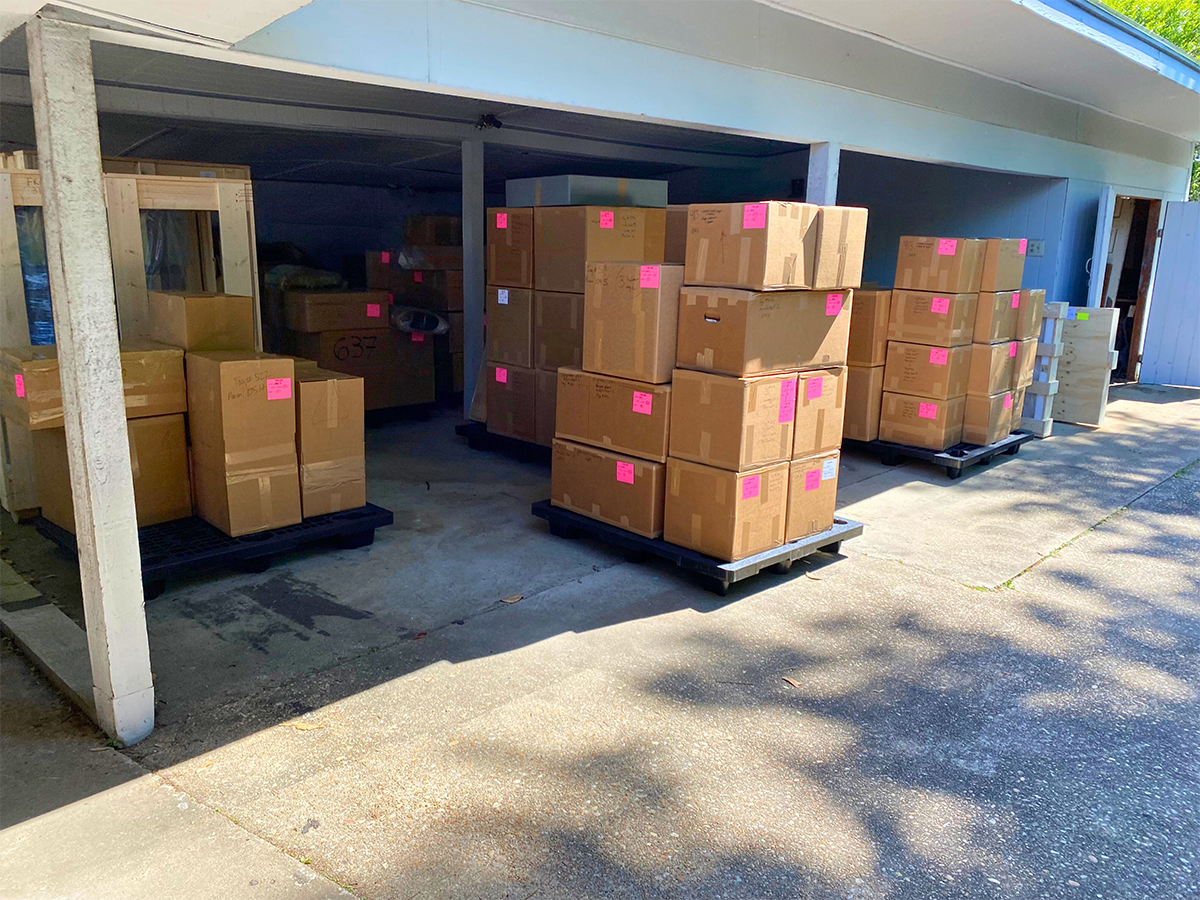 Contents of the Jackson Family Home are packed in boxes and await loading for shipment from Selma, Alabama, to Dearborn, Michigan. / Photograph by Staff of The Henry Ford.
Contents of the Jackson Family Home are packed in boxes and await loading for shipment from Selma, Alabama, to Dearborn, Michigan. / Photograph by Staff of The Henry Ford.
Following the arrival of these materials to Michigan, two-dimensional materials were separated and inventoried as part of The Henry Ford’s Archives and Library collection, located in the Benson Ford Research Center. These materials were then sent to an abatement contractor and gamma irradiated to best preserve them for posterity. This interventive treatment sterilizes and decontaminates potential hazards, without causing any harm to the object. With the materials returned on-site, a processing archivist completed an intensive inventory, intellectually arranging, drafting descriptions, and rehousing the materials to increase accessibility and prepare them for use by researchers and the public.
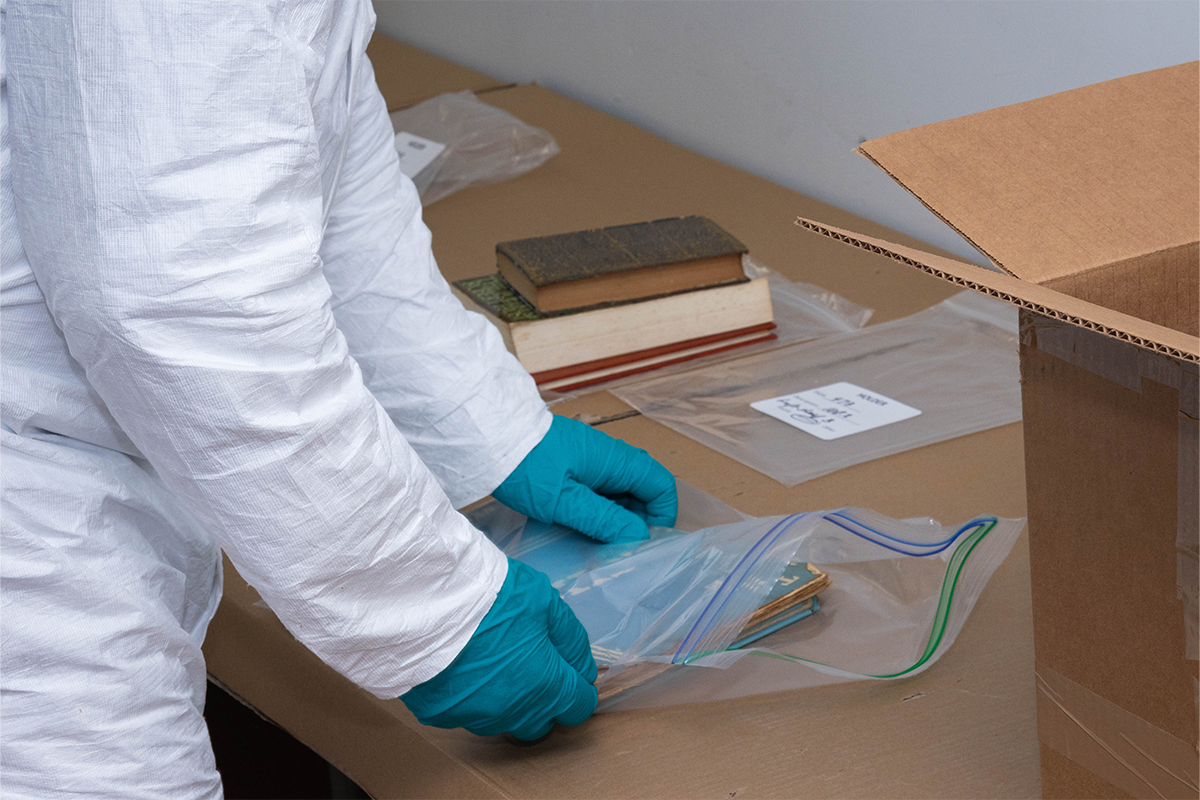 Staff at The Henry Ford organize archive and library materials in preparation for work with an abatement contractor. / Photograph by Staff of The Henry Ford.
Staff at The Henry Ford organize archive and library materials in preparation for work with an abatement contractor. / Photograph by Staff of The Henry Ford.
Many of these materials are being used to fuel the interpretation and visualization of the Jackson Home for its opening in the summer of 2026.
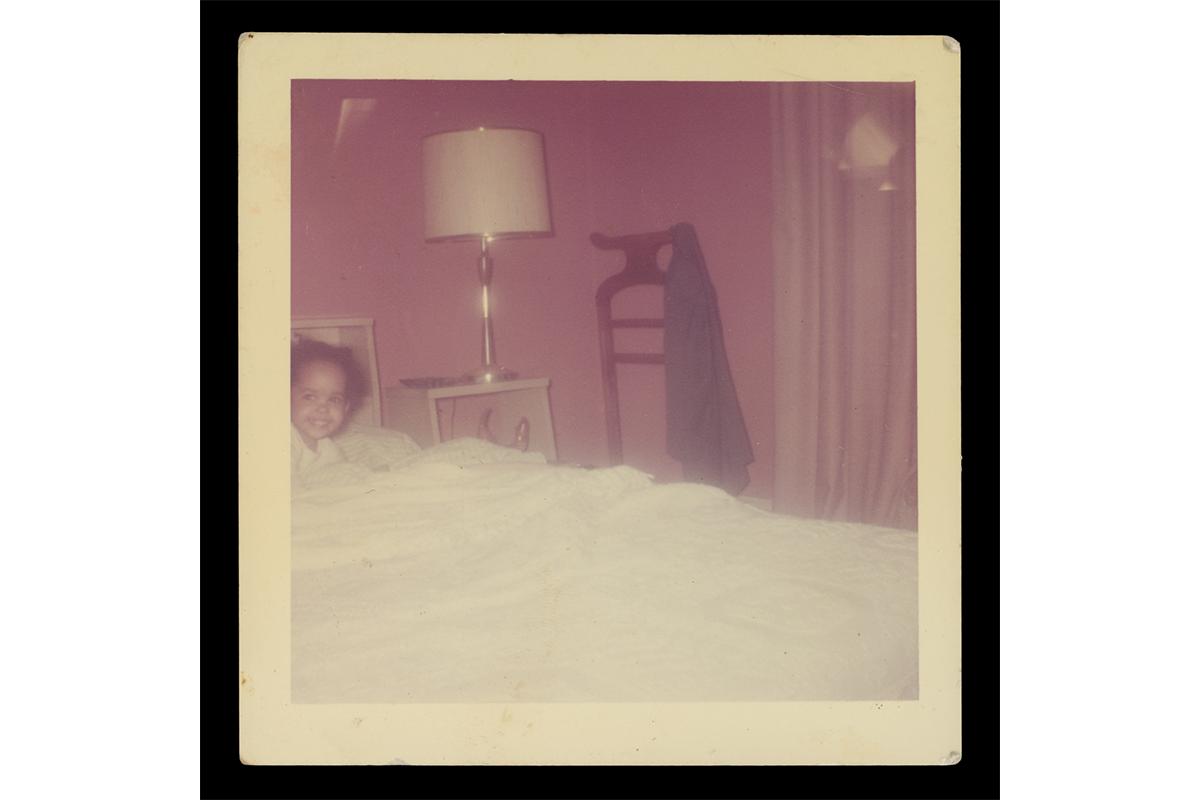 Photograph of Jawana Jackson in the Jackson Family Home. / THF708595
Photograph of Jawana Jackson in the Jackson Family Home. / THF708595
Processing of the three-dimensional artifacts began with unpacking 100 items at a time and assigning a temporary inventory number to each object. This number allows us to track the items as they move through various stages of processing. After inventory, high-resolution reference photographs are captured. This data is uploaded to our digital cataloging system and the items are then transferred to the conservation lab. In April 2023 this phase was completed, but there are several ongoing processing phases that will continue through 2026.
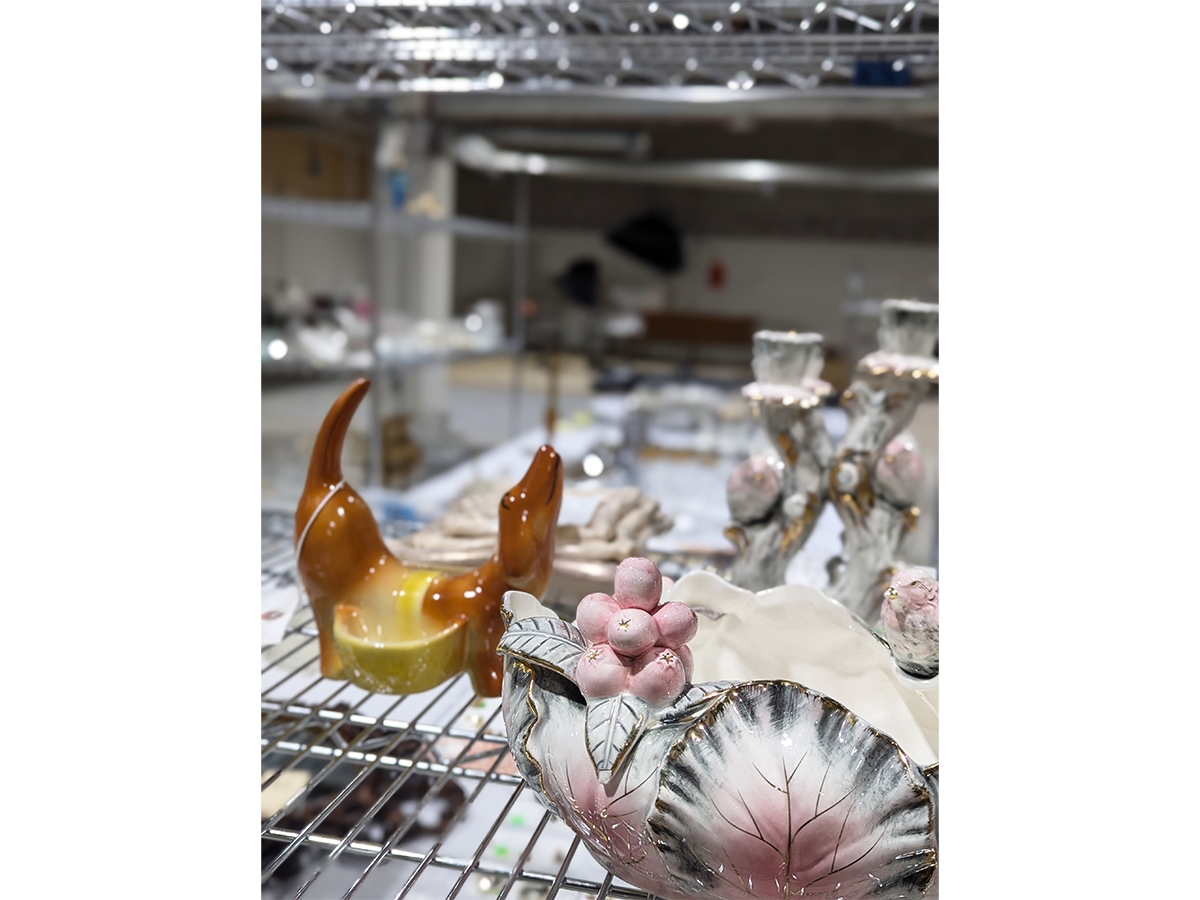 Carts are used to assist in relocating artifacts between stages of processing for the Jackson Home Project. A. L. Hirsch Rover Pottery Dachshund Ceramic Dresser Caddy and United China and Glass Company Pink and White Berries and Bird Leaf bowl are shown being relocated on a cart. / Photograph by Staff of The Henry Ford.
Carts are used to assist in relocating artifacts between stages of processing for the Jackson Home Project. A. L. Hirsch Rover Pottery Dachshund Ceramic Dresser Caddy and United China and Glass Company Pink and White Berries and Bird Leaf bowl are shown being relocated on a cart. / Photograph by Staff of The Henry Ford.
Every artifact from the Jackson Family Home undergoes multiple rounds of cleaning and repair in conservation. The process began when the contents of the home were packed in Selma—where larger items were lightly vacuumed to remove dust. Once on-site at The Henry Ford, each item was thoroughly cleaned and vacuumed during unpacking, providing the first opportunity to check the condition of objects for missing parts or signs of deterioration. Once in the conservation lab, a condition report and treatment plan are created for each object.
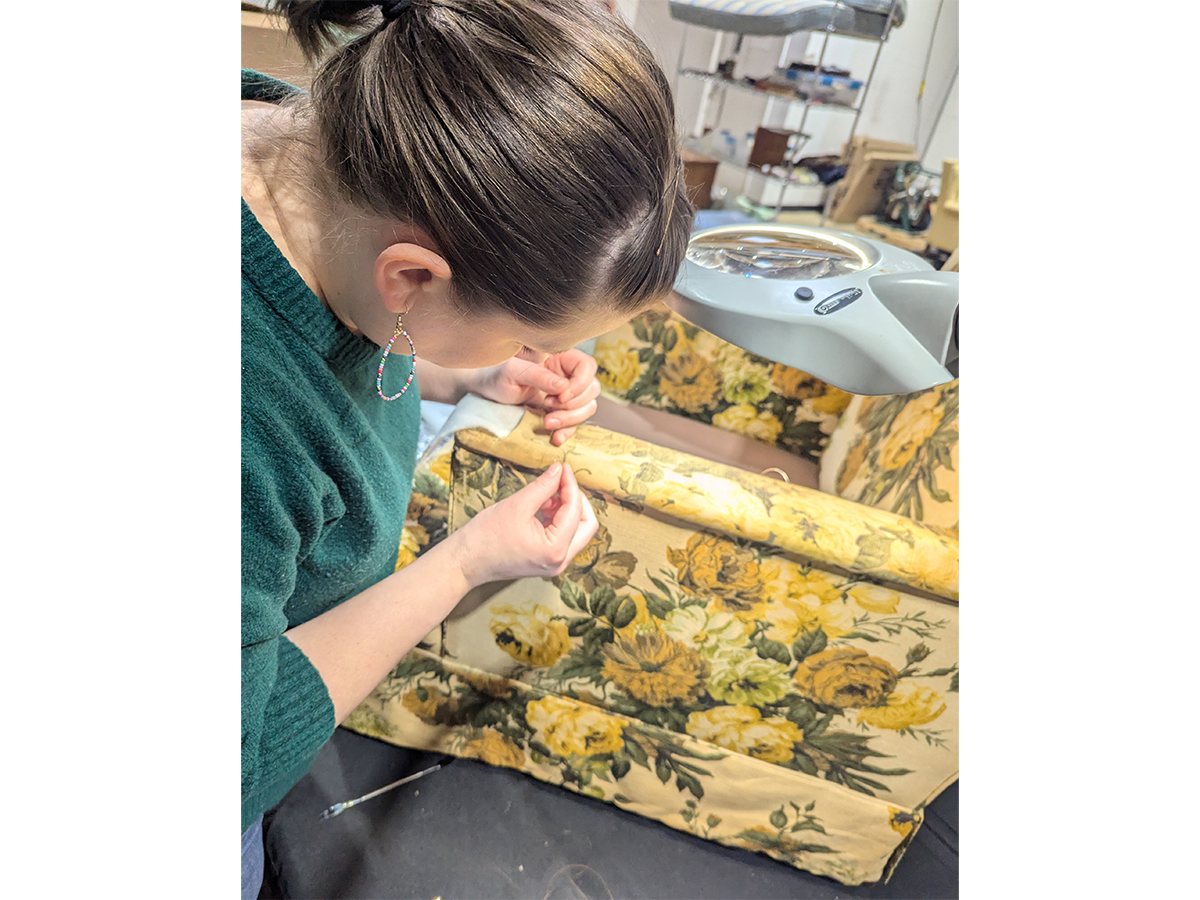 Associate Conservator Kate Herron adds netting to the arms of this Floral Globe Furniture Company armchair, an object used in the Jackson Family Home, for extra stability. / Photograph by Staff of The Henry Ford.
Associate Conservator Kate Herron adds netting to the arms of this Floral Globe Furniture Company armchair, an object used in the Jackson Family Home, for extra stability. / Photograph by Staff of The Henry Ford.
Treatment options can range from light cleaning to restoration or more extensive repairs, depending on the artifact’s condition. Regular meetings with curators at The Henry Ford help determine the appropriate level of cleaning, which items need preservation to address wear or evidence of use, and how each object contributes to the overall narrative.
 Curator of Decorative Arts Charles Sable consults with Conservator Louise Beck on conservation treatment of conservation treatment of a Cosco High chair with steps used in the Jackson Family Home kitchen. / Photograph by Staff of The Henry Ford.
Curator of Decorative Arts Charles Sable consults with Conservator Louise Beck on conservation treatment of conservation treatment of a Cosco High chair with steps used in the Jackson Family Home kitchen. / Photograph by Staff of The Henry Ford.
Simple treatments, like wiping down with deionized water or ethanol, are often sufficient for stable items with light dirt. For kitchen equipment, layers of grease and dust are removed. Some artifacts require more complex treatments, including the repair of broken pieces or removal of corrosion from metals. To prevent deterioration, protective coatings like lacquer are used for brass and silver objects, and specific chemical treatments for iron and steel. Once treatment is complete, the object's condition and treatment details are documented in the catalog record, and the objects continue their journey to The Henry Ford’s registrar staff.
 Yellow Cosco Highchair with steps used in the Jackson Family Home, after conservation treatment. / THF803856
Yellow Cosco Highchair with steps used in the Jackson Family Home, after conservation treatment. / THF803856
The registrar is responsible for research and cataloging each artifact. They build individual catalog records for each object with data such as size, maker, date of creation, and the purpose of the object. Every item is assigned a unique identifier, or an "accession number," that connects that object with a specific record. Accession numbers provide detailed information about the year the object was received into The Henry Ford’s collection, the collection “lot” it is a part of, and the specific registration succession number it is assigned. This unique identification number is attached or physically written on the artifact to ensure it can be traced to its record. Artifacts are labeled in a method that may be removed, if desired or needed down the road, without damage to the object. In addition to the photographic documentation in the collection, this research aids our understanding of what time period(s) the object lived in the Jackson Family Home.
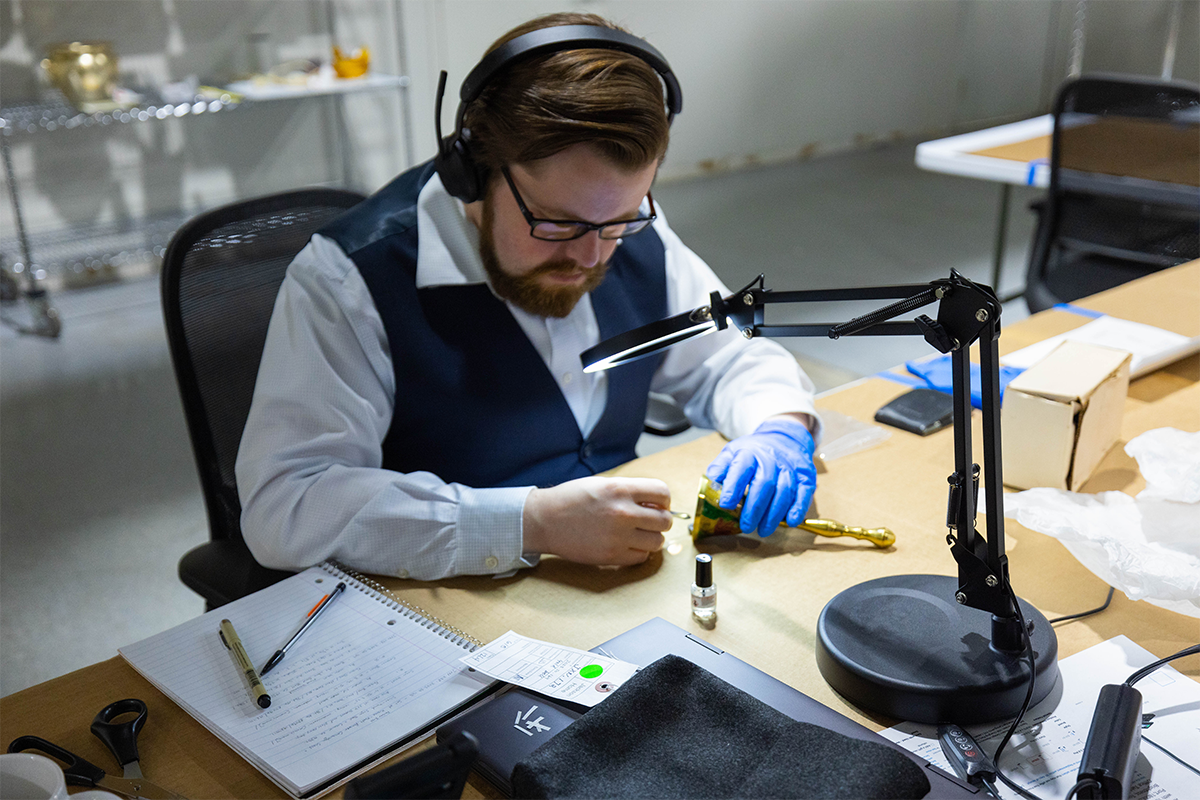 Artifacts in The Henry Ford collection are physically labeled with their accession number. A school bell from the Jackson Family Home is shown being labeled by Collections Specialist-Cataloger Andrew Schneider. / Photo by Staff of The Henry Ford.
Artifacts in The Henry Ford collection are physically labeled with their accession number. A school bell from the Jackson Family Home is shown being labeled by Collections Specialist-Cataloger Andrew Schneider. / Photo by Staff of The Henry Ford.
The artifact then proceeds to photography for a high-resolution image. In 2026 the digitized objects and images from the Jackson Family Home will become accessible to the public on The Henry Ford’s digital collection, which can be accessed on The Henry Ford's Digital Collections website.
 The Henry Ford Photographer Jillian Ferraiuolo, capturing a photograph of a Breakfront China Cabinet from The Jackson Family Home. Digitizing our collection allows artifacts to be accessible, even when not on exhibition. / Photo by Staff of The Henry Ford.
The Henry Ford Photographer Jillian Ferraiuolo, capturing a photograph of a Breakfront China Cabinet from The Jackson Family Home. Digitizing our collection allows artifacts to be accessible, even when not on exhibition. / Photo by Staff of The Henry Ford.
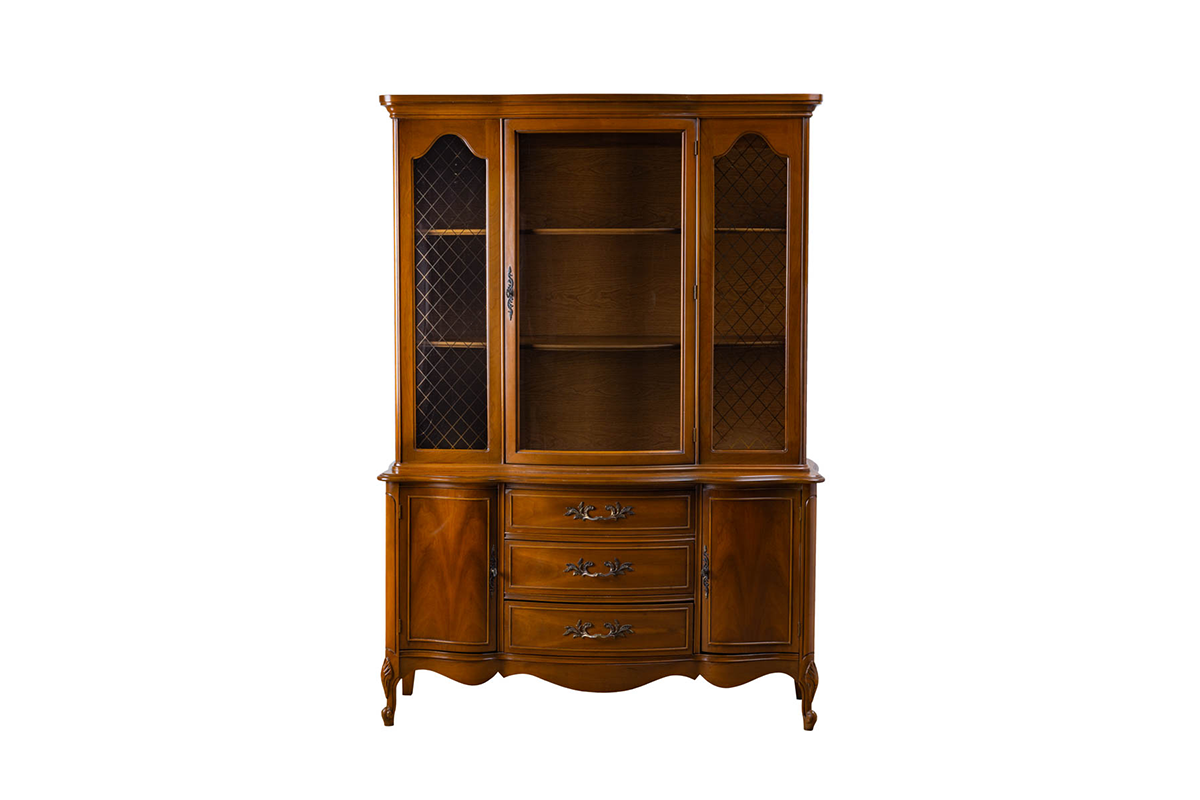 Breakfront China Cabinet. / THF803854
Breakfront China Cabinet. / THF803854
Once processing has concluded, the object is prepared for its new home in the collection, whether that is preparing for handoff to the exhibition team for installation in the Jackson Family Home, used in temporary exhibitions, or moved to storage for future research and opportunities.
This blog was produced by multiple authors: Kristen Hollingsworth, Jackson Home Project Coordinator; Louise Beck, Conservator, Julia DiLaura, Collections Specialist; Ashley Wimbrough, Collections Specialist; Andrew Schneider, Collections Specialist Cataloger; Jack Schmitt, Processing Archivist; and Aidan Thomas, Conservation Specialist at The Henry Ford.
by Kristen Hollingsworth, by Louise Stewart Beck, by Julia DiLaura, by Ashley Wimbrough, by Andrew Schneider, by Jack Schmitt, by Aidan Thomas
The Oldest Cars Shine at 2025 Old Car Festival
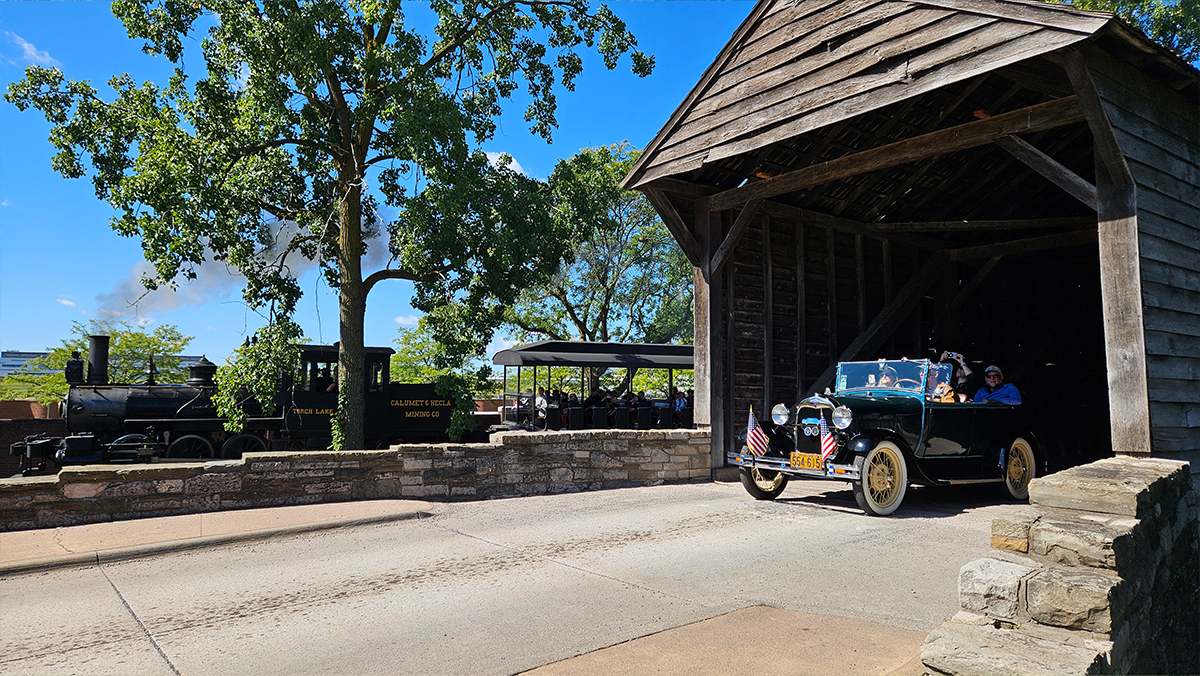
Its top down under bright skies, this Ford Model A kept pace with the Torch Lake locomotive at the 2025 Old Car Festival. / Image by Matt Anderson
Pleasant temperatures and sunny skies greeted visitors and participants alike at our 2025 Old Car Festival, held in Greenfield Village on September 6 and 7. More than 750 vintage cars, trucks, motorcycles, and bicycles registered for this year’s event, making for one of the largest festivals in recent years. Throughout the weekend, the village was filled with the sights and sounds of early gasoline, steam, and electric cars all dating no later than 1932.
We choose a special theme for each year’s show. Often it’s a specific make or model, and sometimes it’s a geographic location or style of automobile. This year we went big by celebrating an entire century with our focus on Nineteenth-Century Motoring. The automobile may have defined the twentieth century, but its origins and earliest impacts lie firmly in the 1800s, from Karl Benz’s pioneering Patent-Motorwagen of 1885 to the Duryea brothers’ first series-produced automobile in 1896.
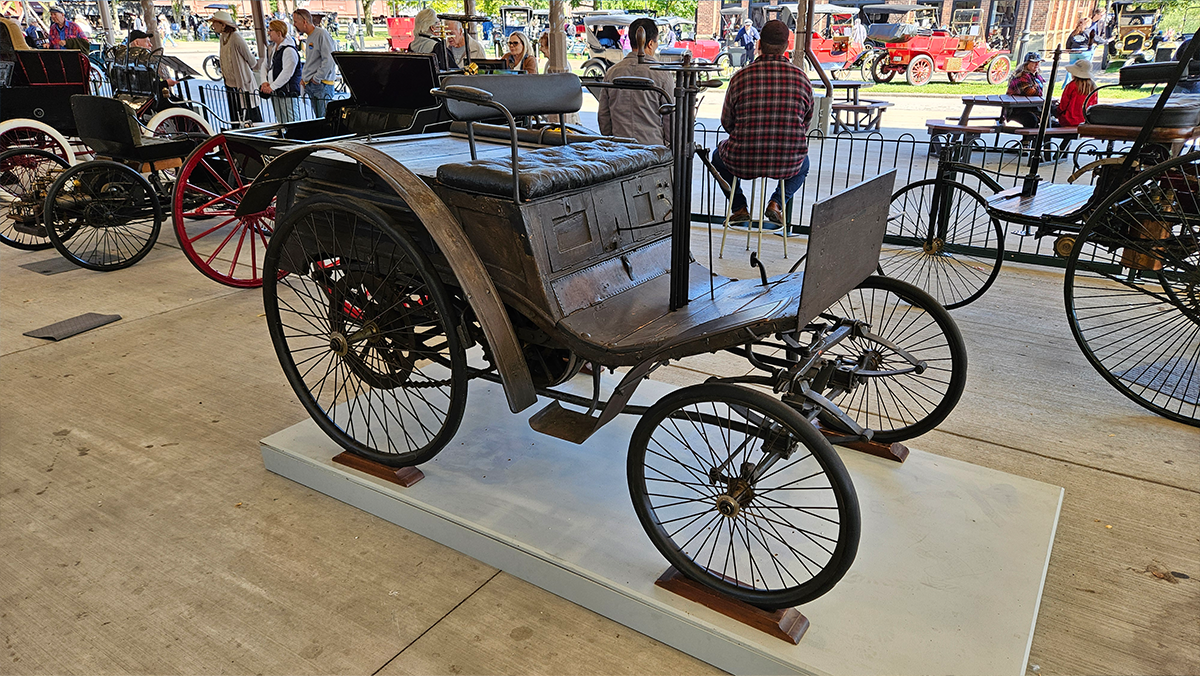
The Henry Ford’s 1893 Benz Velocipede, one of eleven pre-1900 vehicles shown in Detroit Central Market, embodied the festival’s Nineteenth-Century Motoring theme. / Image by Matt Anderson
Incredibly, Old Car Festival featured eleven pre-1900 vehicles in Detroit Central Market. Four of them came from The Henry Ford’s own collection including an 1893 Benz Velocipede, our replica of Henry Ford’s 1896 Quadricycle, an 1898 Autocar Runabout, and, perhaps most interesting of all, a conjectural full-size model of George Selden’s Motor Buggy based on his notorious patent first applied for in 1879 and awarded in 1895. Participants added another five vehicles to the mix, including a replica of an Iowa-built 1890 Morrison Electric, an 1896 Riker Electric prototype, an 1897 De Dion-Bouton Tricycle, an 1898 Beeston Quadricycle, and an 1899 Marot-Gardon. Our neighbors at the Automotive Hall of Fame provided two additional vehicles: replicas of the Benz Patent-Motorwagen and Gottlieb Daimler and Wilhelm Maybach’s 1885 Reitwagen motorcycle.
Visitors were treated to a variety of experiences throughout the village. Not far from the entrance, at the Ford Home, the Early Engine Club staged a Farm Power Expo showcasing early tractors and stationary engines, including The Henry Ford’s Pullford farm tractor — created from a Ford Model T using a widely marketed conversion kit. Outside the nearby Bagley Avenue Workshop, presenters demonstrated a replica of Henry Ford’s 1893 Kitchen Sink Engine that represented his first steps in the nascent automotive industry.
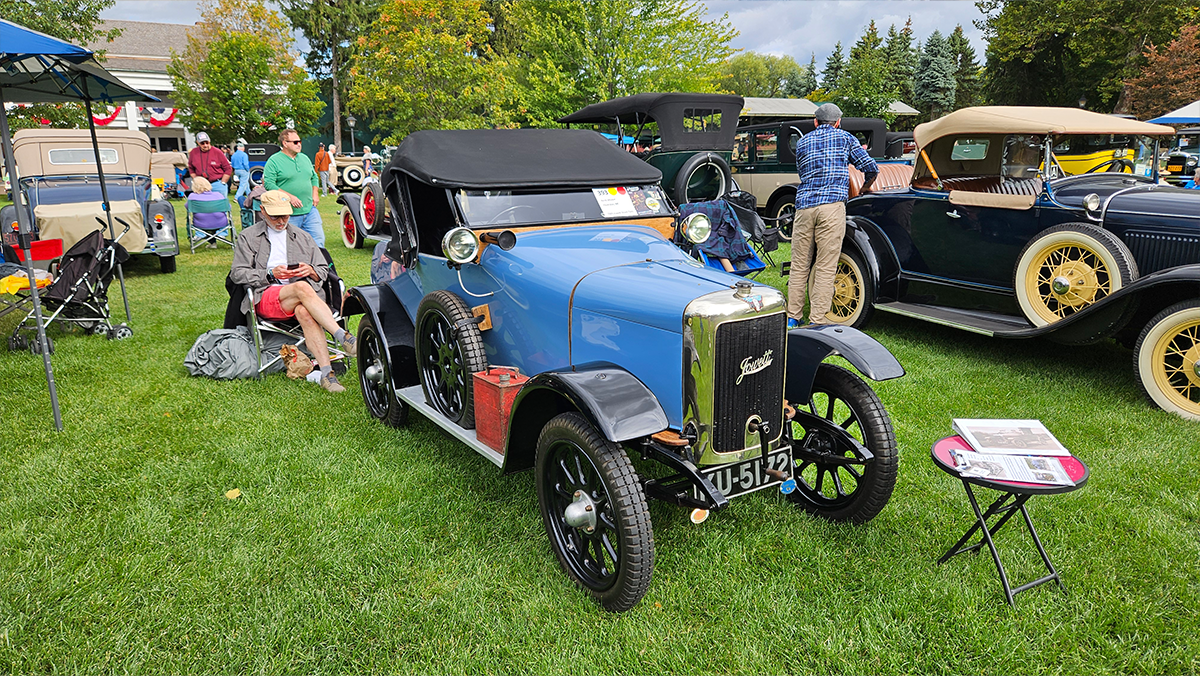
Old Car Festival included a number of imports like this 1924 Jowett made in Great Britain. / Photo by Matt Anderson
As is the custom at Old Car Festival, participating vehicles were parked in chronological order throughout Greenfield Village. The earliest automobiles sat near the Armington & Sims Machine Shop near the village entrance, while late 1920s and early 1930s cars had space near the Daggett Farmhouse. The Village Green was reserved for judged cars. Vehicle class awards were given based on authenticity, quality of restoration work and the care with which each car was maintained. First-, second- and third-place prizes were awarded in eight classes, and one overall Grand Champion was selected for the festival. We also presented two Curator’s Choice Awards to two unrestored vehicles. The complete list of our 2025 Old Car Festival award winners is available here.
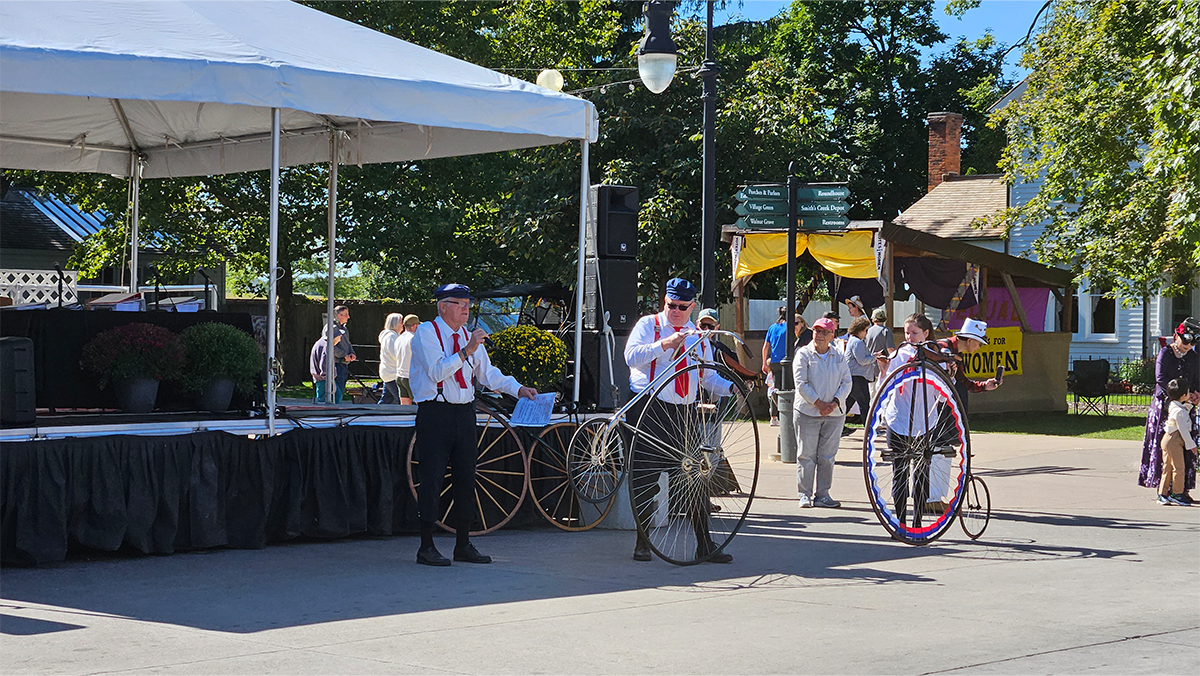
Bicycles had their own pass-in-review sessions, ably narrated by Bill Smith, on Saturday and Sunday mornings. / Photo by Matt Anderson
Old Car Festival visitors were welcome to explore the village and learn about the cars on their own. As always, participants were eager to share stories and insights about their vehicles. But visitors interested in a more formal presentation could attend pass-in-review sessions throughout the weekend. Vintage vehicles were driven past a set of bleachers on Main Street where expert historians offered commentary on each one. Sometimes the narration included dates and production figures for a vehicle’s manufacturer, and other times it was a broader statement on that car’s impact on technology or design. These narrated sessions also provided an opportunity for us to individually thank our participants by giving them a moment in the spotlight.
Martha-Mary Chapel hosted its own series of special presentations. Automotive historian Andy Dervan shared a look at Ford Motor Company’s monthly publication, Ford Times, which launched in April 1908. Always promotional but often informative, Ford Times included travelogues, customer testimonials and general news on the company and its products. Roadside historian Daniel Hershberger shared insights on automobile touring and camping in the first decades of the 20th century. Not far from the chapel, next to Scotch Settlement School, Hershberger staged an impressive display of vintage camping equipment. Meanwhile, presenter Ray Swetman offered an informative talk in the chapel about Henry Ford’s efforts to finance Ford Motor Company, his third attempt at auto production, in 1903.
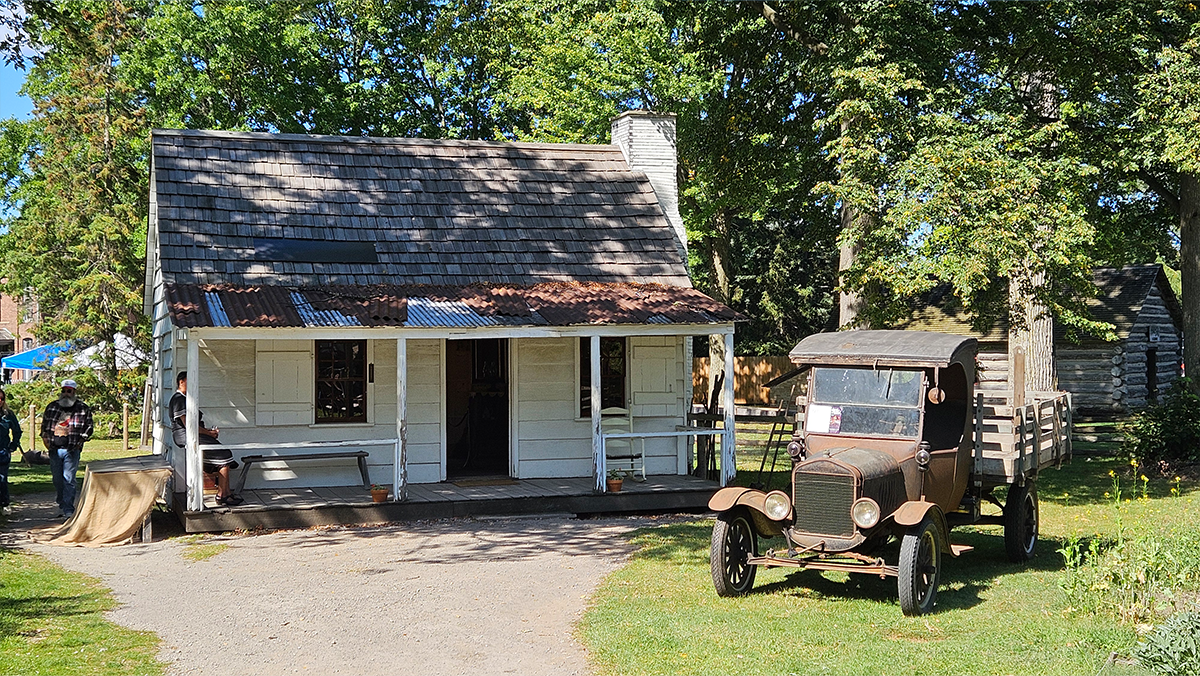
The Georgia farmhouse of Amos and Grace Mattox represented the trying Depression years, accented by a well-worn Ford Model TT parked out front. / Image by Matt Anderson
Music featured prominently in this year’s show. Old Car Festival’s 40-year timespan allowed for a variety of musical styles. The corner of Washington Boulevard and Post Road hosted a ragtime street fair, complete with a cakewalk set to syncopated piano rags by Scott Joplin and other giants of the genre. The River Raisin Ragtime Review orchestra joined the festivities on Saturday evening with a concert on Main Street. Throughout the weekend at the Mattox Family Home, Rosa Warner-Jones performed a selection of poignant gospel and blues songs evocative of the Georgia lowlands during the Great Depression. The Village Trio vocal group, the Greenfield Village Quartet and other artists added to the experience.
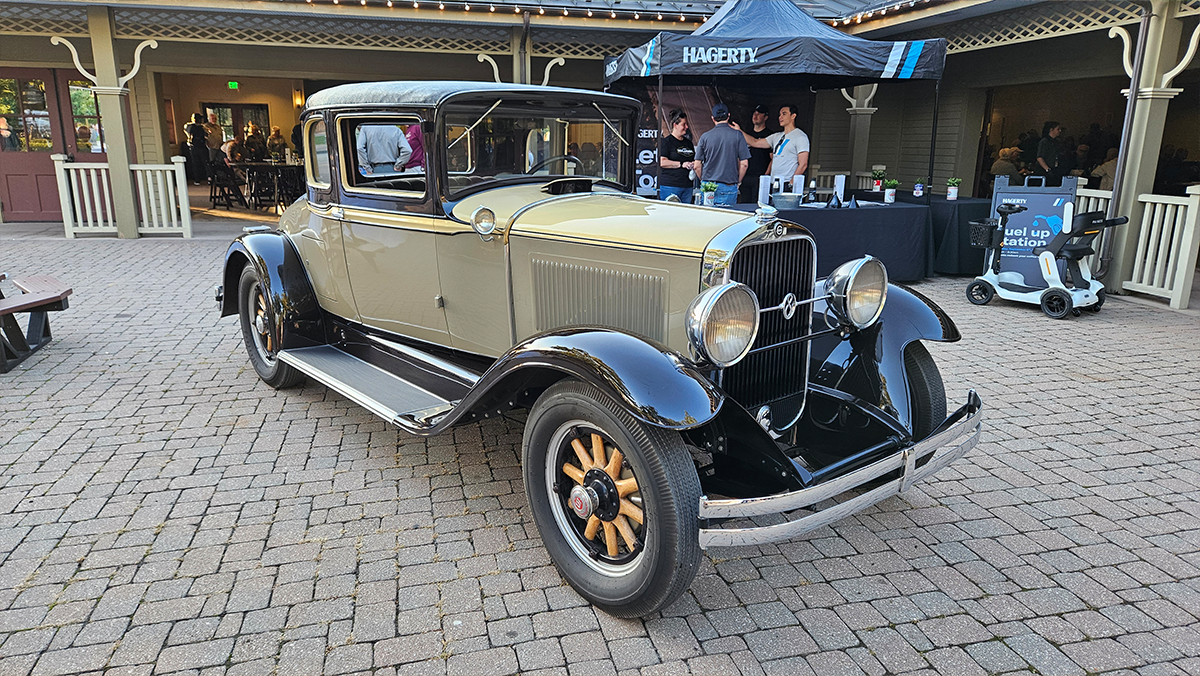
Hagerty’s 1930 Studebaker Victoria coupe drew onlookers at the Lodge. / Image by Matt Anderson
Once again, our friends at Hagerty helped make Old Car Festival the success it was. Not only did they sponsor their terrific youth judging program, in which children 8-10 years old get to view and choose their favorite cars; Hagerty also brought a 1930 Studebaker Commander 8 that fit in perfectly at the show. Hagerty had an active presence near the Herschell-Spillman Carousel with magazines, newsletters and fun promo products available to all comers.
We extend a special thanks to all the participants, presenters, performers and guests who made the 2025 Old Car Festival so special. This one may be in the history books, but you can be sure that we’re already looking forward to next year.
Matt Anderson is Curator of Transportation at The Henry Ford.
The Many Journeys of The House by the Side of the Road
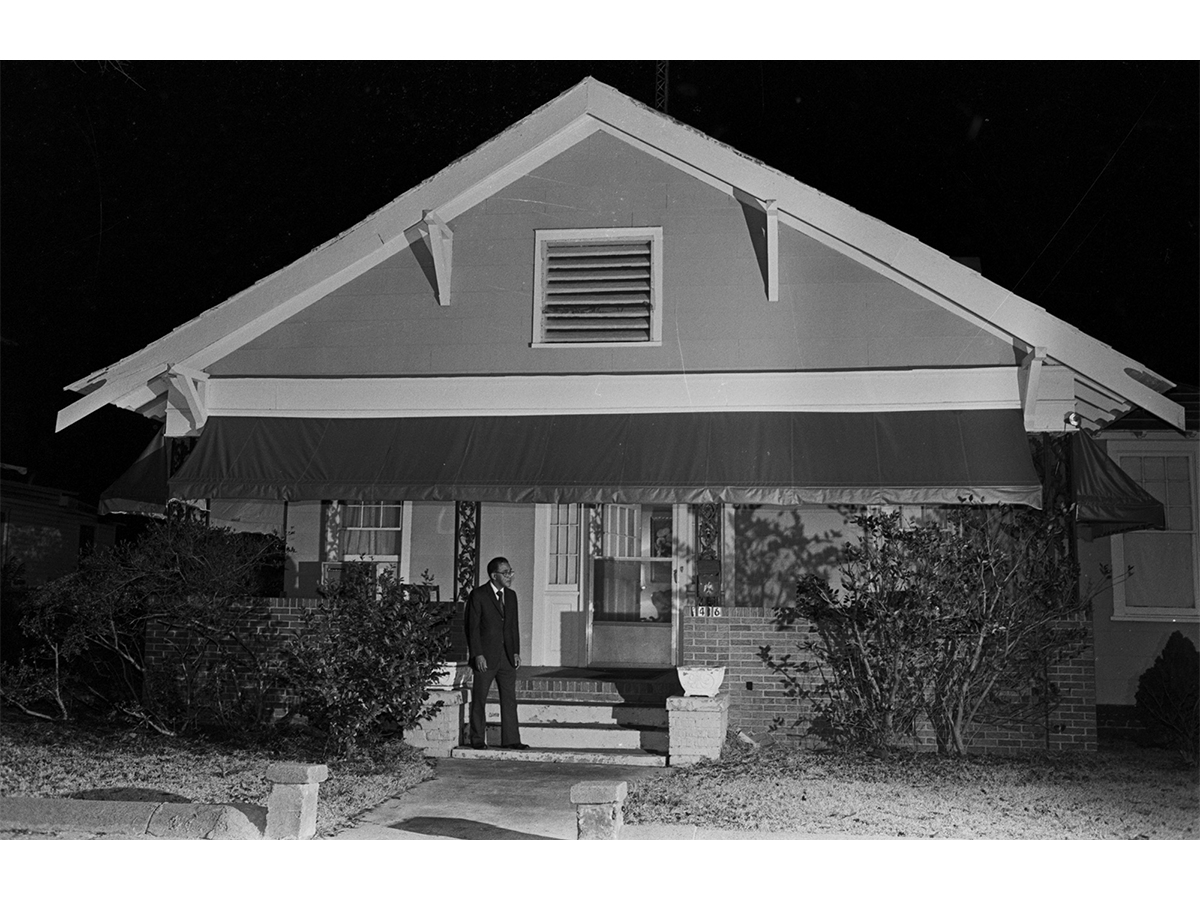 Dr. Sullivan Jackson on the front steps of The Jackson Home, circa 1999. The house reflects changes made in the late 1960s and 1970s. / Alabama Department of Archives and History. Donated by Alabama Media Group / Photo by Ed Jones, Birmingham News.
Dr. Sullivan Jackson on the front steps of The Jackson Home, circa 1999. The house reflects changes made in the late 1960s and 1970s. / Alabama Department of Archives and History. Donated by Alabama Media Group / Photo by Ed Jones, Birmingham News.
In 2026, The Jackson Home from Selma, Alabama, will open in Greenfield Village, becoming the first home to be added to this collection of historic structures in over 40 years. The home comes to us with the inspiring story of a courageous family and community at the forefront of one of the most crucial moments in the Civil Rights Movement in America. Their tireless efforts, spotlighted on national and world stages, would eventually lead to the signing of the Voting Rights Act on August 6, 1965.
During the first months of 1965, the home of Dr. Sullivan and Mrs. Richie Jean Jackson and their young daughter, Jawana, served as a key backdrop to the world-changing events in Selma. Their modest yet well-appointed home provided a safe haven for Rev. Dr. Martin Luther King Jr. and other civil rights activists planning the Selma-to-Montgomery marches, and acted as a communication hub, including ongoing calls to and from the White House.
It’s fitting that this home joins buildings associated with other extraordinary Americans, such as Abraham Lincoln, George Washington Carver, Thomas Edison, the Wright Brothers, and Henry Ford, who also achieved remarkable things. It’s also fitting that The Jackson Home is not a grand mansion. Instead, the home is an Arts & Crafts single-story southern bungalow, a style that became prevalent in neighborhoods across the country in the early 20th century. While Greenfield Village has a few 20th-century buildings, none are of this Arts & Crafts style.
The home will be restored to its 1965 appearance, both inside and out, reflecting the changes made by three generations of African American dentists who lived there between 1919 and 1965.
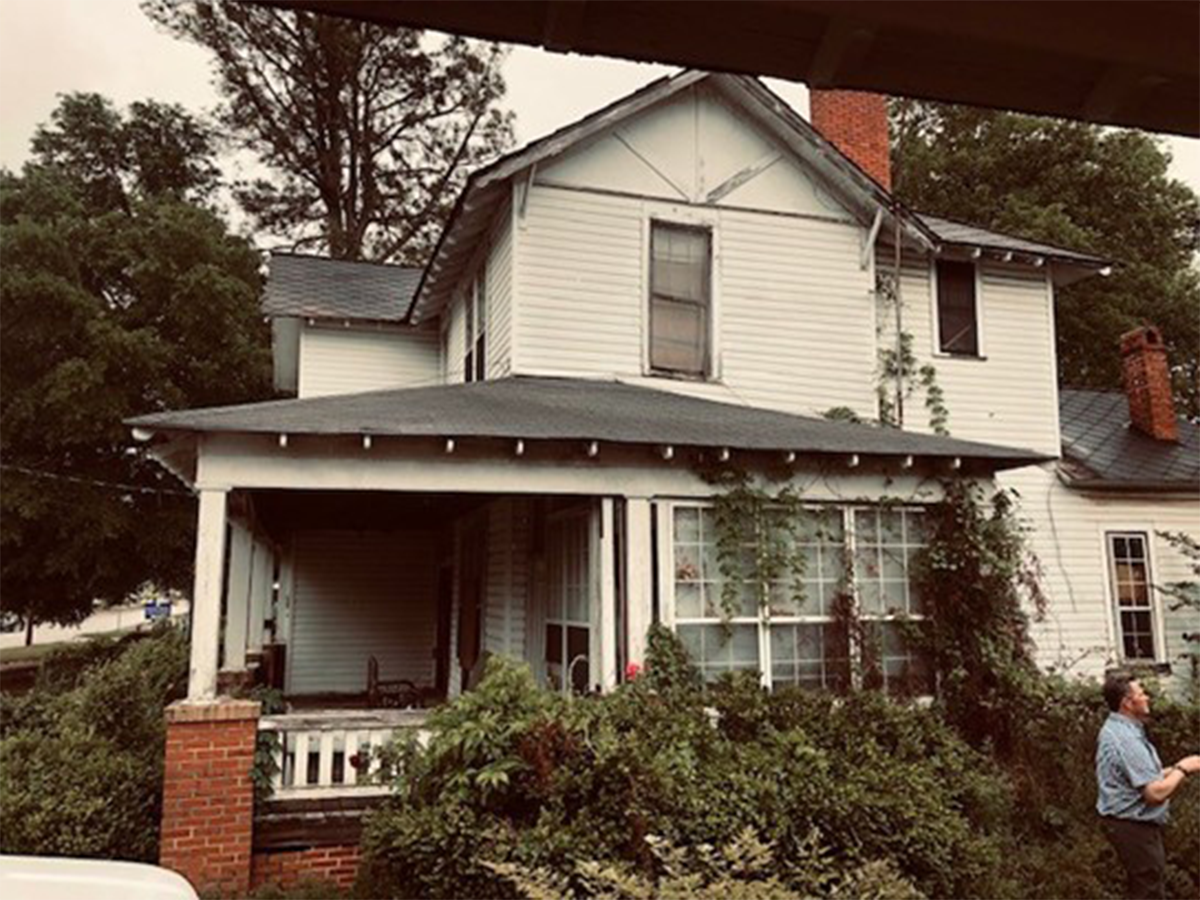 The home of Dr. R.B. Hudson, next door to The Jackson Home. Designed by Wallace A. Rayfield in 1910
The home of Dr. R.B. Hudson, next door to The Jackson Home. Designed by Wallace A. Rayfield in 1910
The Jackson Home was commissioned by Dr. Richard Hudson as a wedding gift for his daughter, Leola Hudson, in 1919. Dr. Hudson was a prominent Alabama businessman and an important figure in Alabama’s black educational community. He was closely associated with Dr. Booker T. Washington and the Tuskegee Institute (now University), and was a benefactor of Selma University, which stood just down the street from his home. Hudson’s own home was designed by Wallace A. Rayfield in 1910, so it is not surprising that the new home for his daughter and her new husband, Dr. William Whitted, would also be a Rayfield design.
 Wallace A. Augustus Rayfield and students in a mechanical drawing class at the Tuskegee Institute, Tuskegee, Alabama, circa 1902. / Photograph by Frances Benjamin Johnston, courtesy of Library of Congress
Wallace A. Augustus Rayfield and students in a mechanical drawing class at the Tuskegee Institute, Tuskegee, Alabama, circa 1902. / Photograph by Frances Benjamin Johnston, courtesy of Library of Congress
 Wallace A. Rayfield provided designs for the remodeling of the home of Dr. L.L. Burwell in 1910. The Burwells are related to The Jacksons and this home stood just around the corner from The Jackson Home. / THF725295
Wallace A. Rayfield provided designs for the remodeling of the home of Dr. L.L. Burwell in 1910. The Burwells are related to The Jacksons and this home stood just around the corner from The Jackson Home. / THF725295
The connection to Wallace A. Rayfield emerged early in our Jackson Home research. At the time the house was built, Rayfield was one of only two formally trained African American architects in America. After earning degrees from Howard University, Columbia, and the Pratt Polytechnic Institute, he began his career teaching architectural design and technical drawing at Tuskegee Institute. In 1908, Rayfield opened his own firm in Birmingham, Alabama, where he built a thriving business designing homes, schools, churches, and other public buildings for the growing black middle class. In 1909, Rayfield designed the famous 16th Street Baptist Church in Birmingham, the site of the horrific bombing that killed four young girls in 1963.
 16th Street Baptist Church, Birmingham, Alabama, designed by Wallace A. Rayfield in 1909. / THF725347
16th Street Baptist Church, Birmingham, Alabama, designed by Wallace A. Rayfield in 1909. / THF725347
 Floor plan of The Jackson Home highlighting each of the additions. / From the Historic Structures Report prepared by Quinn Evans.
Floor plan of The Jackson Home highlighting each of the additions. / From the Historic Structures Report prepared by Quinn Evans.
Dr. William and Leola Whitted lived in the home from their marriage in 1919 until Dr. Whitted’s death in 1940. In its first iteration, the house was sided in narrow painted clapboard with a wooden shingled roof. It ended at the kitchen door, with another doorway leading out from the hallway onto a covered porch. The house was heated by individual fireplaces with coal grates, with a coal stove likely in the kitchen, and featured indoor plumbing and electricity. Remarkably, all the original 1919 windows survived and will be reinstalled in the house.
In the late 1930s, as Dr. Whitted's health declined, Dr. Eric Portlock, a cousin of Leola's, joined the dental practice. After Dr. Whitted's death in 1940, Dr. Portlock took over the practice, and he and his wife, Bennie, moved into the house as tenants, while Leola relocated to Montgomery.
Under Bennie Portlock's care, the home became a center of hospitality for many of the women's groups, church organizations, and Selma University functions in which she was involved. Her love for gardening, flowers, and color became evident as she put her own stamp on the decor of the house.
 Birthday party for Rose Marie Foster (seated) hosted by Mrs. Bennie Portlock (directly behind Rose). This circa 1953 image shows the original features of the dining room and some of Mrs. Portlock's floral wallpaper. Marie Foster, one of Selma's “Courageous Eight,” stands next to her daughter, Rose. Marie was the sister of Sullivan Jackson and worked as a dental hygenist for both Dr. Portlock and Dr. Jackson. / THF708432
Birthday party for Rose Marie Foster (seated) hosted by Mrs. Bennie Portlock (directly behind Rose). This circa 1953 image shows the original features of the dining room and some of Mrs. Portlock's floral wallpaper. Marie Foster, one of Selma's “Courageous Eight,” stands next to her daughter, Rose. Marie was the sister of Sullivan Jackson and worked as a dental hygenist for both Dr. Portlock and Dr. Jackson. / THF708432
In the early 1950s, the Portlocks made significant upgrades to the house, including a large rear addition with a full bathroom, den, and bedroom. Along with these changes, they extensively decorated with colorful wallpapers. The kitchen was partially remodeled and updated, but the original 1919 kitchen cabinets remained in place.
 The kitchen of The Jackson Home in 1959. / THF708492
The kitchen of The Jackson Home in 1959. / THF708492
 The kitchen of The Jackson Home in 1959. / THF708428
The kitchen of The Jackson Home in 1959. / THF708428
Around this same time, the Portlocks also resided the house in a wide cement board (a maintenance-free upgrade to the painted wooden siding) finished in a fashionable salmon color with white trim, and added a metal shingle roof over the original wooden shakes. These exterior changes remained in place through 1965 and will be restored.
Dr. Portlock died in 1955. Bennie remained in the house alone until 1958, when Dr. Jackson and Richie Jean Sherrod moved in after their marriage. Dr. Jackson had joined the practice in the mid-1950s. Richie Jean was a cousin to Leola Whitted, the owner of the house, and would eventually inherit the home.
From 1958 onward, Richie Jean gradually added her own modern touches to the home's decor. The birth of Jawana Jackson in July 1960 brought further changes. It's important to note that very soon after The Jacksons moved into the home, Dr. Martin Luther King Jr. and his colleagues became frequent house guests while visiting Selma College for seminars and lectures. By this time, Dr. King and the Jacksons had become close friends, and The Jackson Home was a safe haven.
In November 1964, Dr. King contacted The Jacksons about coming to Selma to expose the voting inequities happening there and asked if their home could be a planning base. The Jacksons quickly agreed, and Richie Jean redecorated, painting over the aging wallpaper and installing new carpeting throughout the house. Family photos of this period show these changes taking place, while the house’s exterior remained unchanged through 1965.
 Artist’s rendering of The Jackson Home returned to its 1965 appearance. / Photo from The Henry Ford’s Experience Schematic Design Report
Artist’s rendering of The Jackson Home returned to its 1965 appearance. / Photo from The Henry Ford’s Experience Schematic Design Report
By 1967, the front porch’s wooden columns and crisscrossed railing were replaced with wrought iron. In the mid-1970s, the porch was further transformed into a brick half-walled space with a ceramic tile floor. The same brick was used to infill between the original piers and remodel the living room fireplace. Major renovations also included new drywall throughout the home, a remodeled kitchen, and the addition of a “lower den” family room. These changes, made after 1965, have since been removed to restore the home’s original 1965 appearance, with missing elements to be reproduced and reinstated to their original locations.
 The front of The Jackson Home, circa 1963. This image shows the 1950s configuration of the front porch that remained intact through 1965. / THF708601
The front of The Jackson Home, circa 1963. This image shows the 1950s configuration of the front porch that remained intact through 1965. / THF708601
 The front porch of The Jackson Home, Easter 1967, showing the recent addition of the wrought-iron railing and columns that replaced the wooden columns and railing. / THF718533
The front porch of The Jackson Home, Easter 1967, showing the recent addition of the wrought-iron railing and columns that replaced the wooden columns and railing. / THF718533
The Jackson Home has been part of many journeys. Among them are the lives of three generations, world-changing historical events and their aftermaths, a thousand-mile move from Selma, Alabama, to Dearborn, Michigan, and now, a journey back in time to 1965. Many of us have had the honor of being part of these last legs of the home’s journey, an honor we will not soon forget.
 One half of The Jackson Home in its shipping container arriving at Greenfield Village and its two halves reunited on its new foundation. / Photos by Staff of The Henry Ford
One half of The Jackson Home in its shipping container arriving at Greenfield Village and its two halves reunited on its new foundation. / Photos by Staff of The Henry Ford
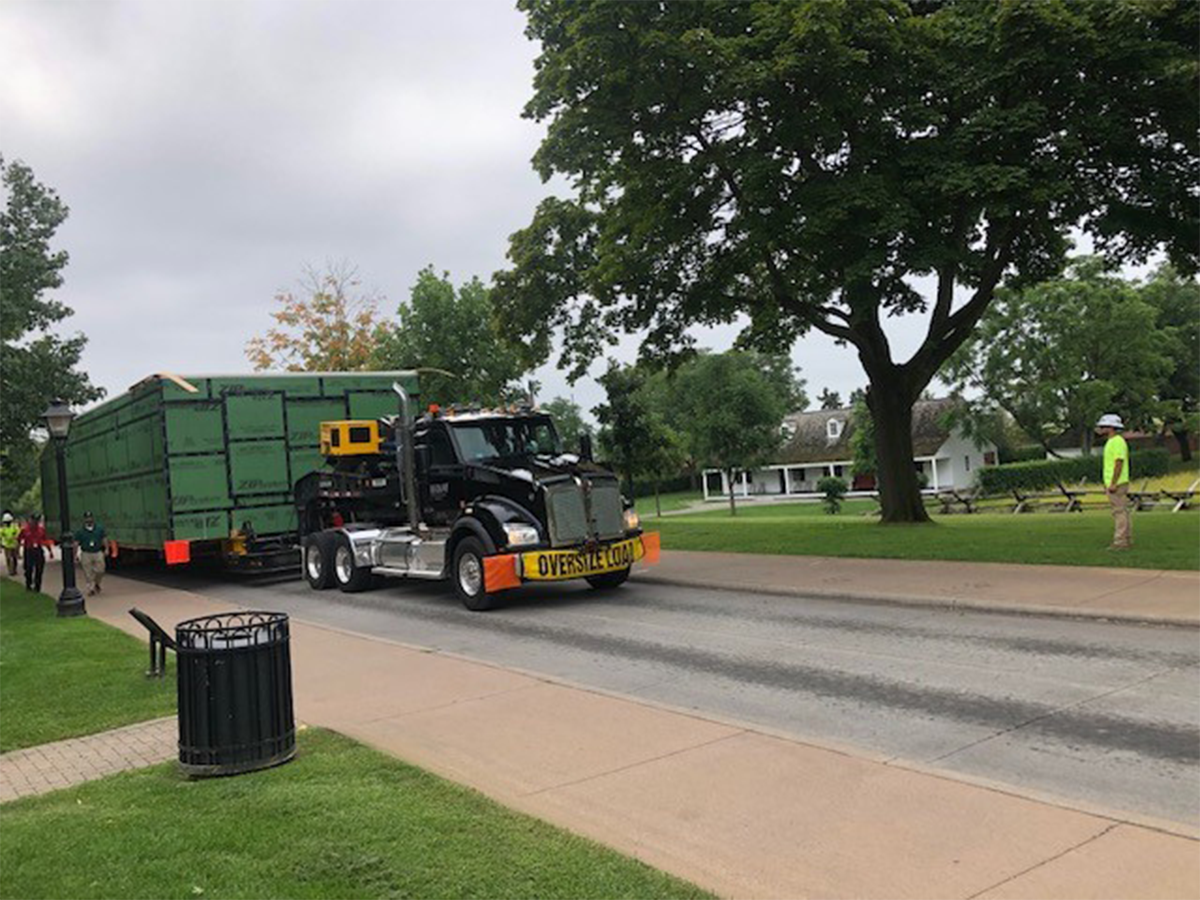 One half of The Jackson Home in its shipping container arriving at Greenfield Village and its two halves reunited on its new foundation. / Photos by Staff of The Henry Ford.
One half of The Jackson Home in its shipping container arriving at Greenfield Village and its two halves reunited on its new foundation. / Photos by Staff of The Henry Ford.
- Brown, Charles A. W.A. Rayfield: Pioneer Black Architect of Birmingham, Alabama, Gray Printing Co., Birmingham, AL, 1977.
- Durough, Allen R., The Architectural Legacy of Wallace A. Rayfield, The University of Alabama Press, Tuscaloosa, 2010.
- Jackson, Richie Jean Sharrod, The House by the Side of the Road, The University of Alabama Press, Tuscaloosa, 2011.
- Historic Structures Report, The Sullivan and Richie Jean Jackson House, prepared by Quinn Evans, Ann Arbor, MI 2023.
- Van West, Carroll, and Richie Jean Jackson House National Register Nomination, Washington, DC: United States Department of Interior, National Park Service, 2013.
James R. Johnson is Director, Greenfield Village & Curator of Historic Structures & Landscapes at The Henry Ford.
*Batteries and Fuel Not Included: The Hop Rod, the World’s First “Powerized” Pogo Stick
Over the years many fun-but dangerous-toys have been marketed to children, only to be discontinued or banned. Remember chemistry sets with toxic materials? Or lawn darts capable of serious injury? Then there was the Hop Rod-a pogo stick powered by a combustion engine. Exploring the history of pogo sticks can help us understand the brief, explosive rise (and fall) of the Hop Rod in the early 1970s.
Early Hopping
Stilts were popular in 19th-century America for entertainment and recreation, and useful as tools for agricultural tasks. Among their early innovators was George H. Herrington, a bookstore owner from Wichita, Kansas, who held at least seven U.S. patents, including for a phonograph, fire escape, and typewriting machine. In February 1881 Herrington received a U.S.patent for his “spring-stilt” - a pair of wooden stilts with compression springs under each foot, intended to help users leap “great distances and heights.”
 Illustration from U.S. Patent 238,042, issued to George H. Herrington of Wichita, Kansas, on February 22, 1881 / United States Patent and Trademark Office
Illustration from U.S. Patent 238,042, issued to George H. Herrington of Wichita, Kansas, on February 22, 1881 / United States Patent and Trademark Office
The Hopping '20s
Fast forward to Europe. Germans Ernst Gottschall and Max Pohlig received a patent in 1920 for a "springy-looking hopping stuff." Unlike Herrington’s, it was just one stilt, with a spring mounted between the pole and base and a double footrest. The name “pogo” is believed to be derived from the first two letters of their last names—a common naming practice in Germany at the time. Around the same period, British inventor Walter Lines patented a similar vertical single-handled “hopping-pole."
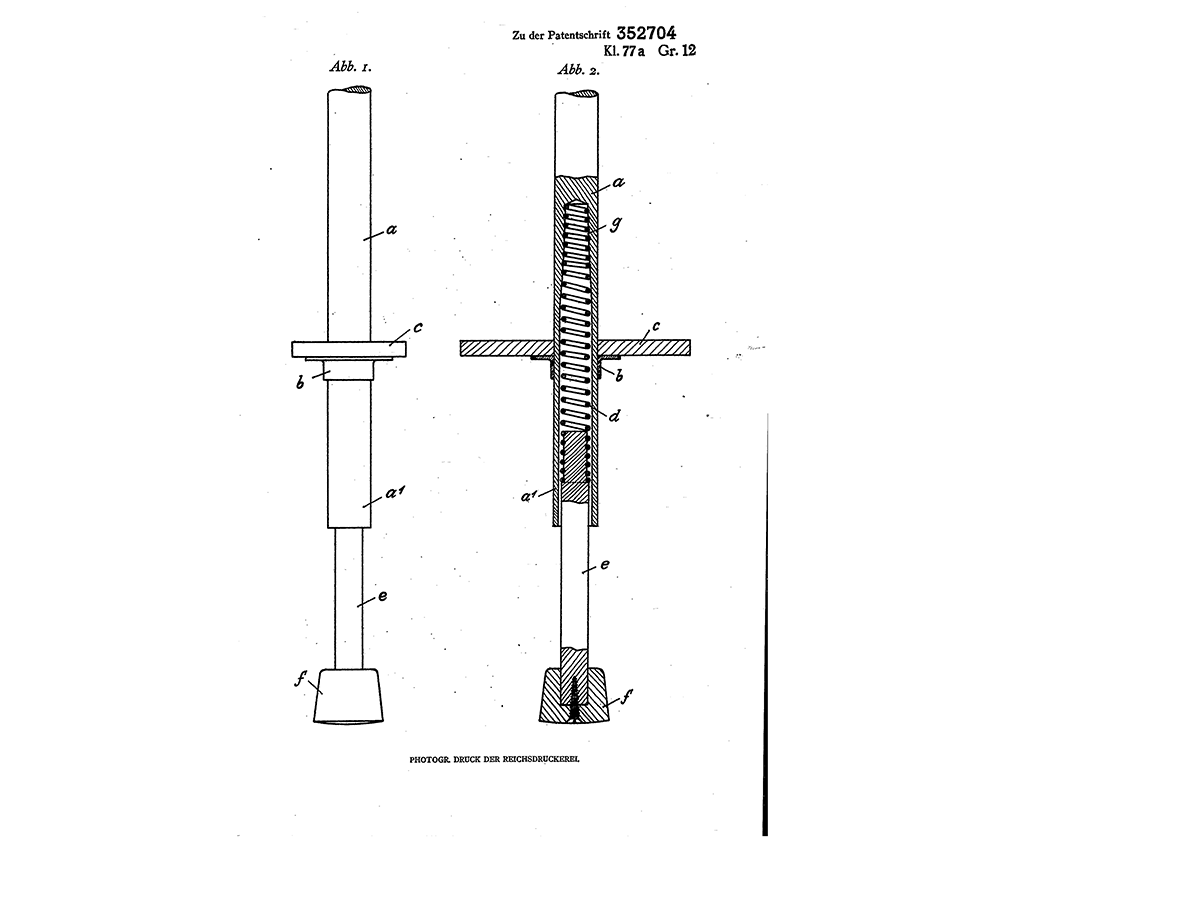 An illustration from Gottschalk and Pohlig’s patent for the “Federnd wirkende Hupfstelze” (“springy-looking hopping stilt”), issued in Hanover, Germany, March 9, 1920 / German Patent and Trade Mark Office.
An illustration from Gottschalk and Pohlig’s patent for the “Federnd wirkende Hupfstelze” (“springy-looking hopping stilt”), issued in Hanover, Germany, March 9, 1920 / German Patent and Trade Mark Office.
As pogo sticks gained popularity in Europe, American sporting goods and department stores placed orders with overseas manufacturers. One New York City department store, however, received an order of pogo sticks that had mildewed and decomposed due to the damp conditions on the ship. Stores began looking for U.S manufacturers. George Hansburg’s SBI Enterprises in Ellenville, New York, started manufacturing pogo sticks. By June 1922, the word “pogo” was trademarked in the United States to refer to a jumping stick.
 A 1920s pogo stick with a single vertical post, which could cause injuries to the rider’s chin. / THF805470 (left), THF805474 (right)
A 1920s pogo stick with a single vertical post, which could cause injuries to the rider’s chin. / THF805470 (left), THF805474 (right)
Though often credited as the pogo stick’s inventor, George Hansburg did not patent anything resembling a pogo stick in the 1920s. However, the United States experienced its first pogo stick boom in the 1920s due to the increased domestic production. Contests, races, and other pogo stunts popped up across the country. The Ziegfeld Follies even developed a stage show that featured performers on pogo sticks. Hansburg eventually redesigned the pogo stick – with double horizontal handles to reduce the risk of chin injuries from the vertical pole and received a U.S. patent for this improved design in 1957.
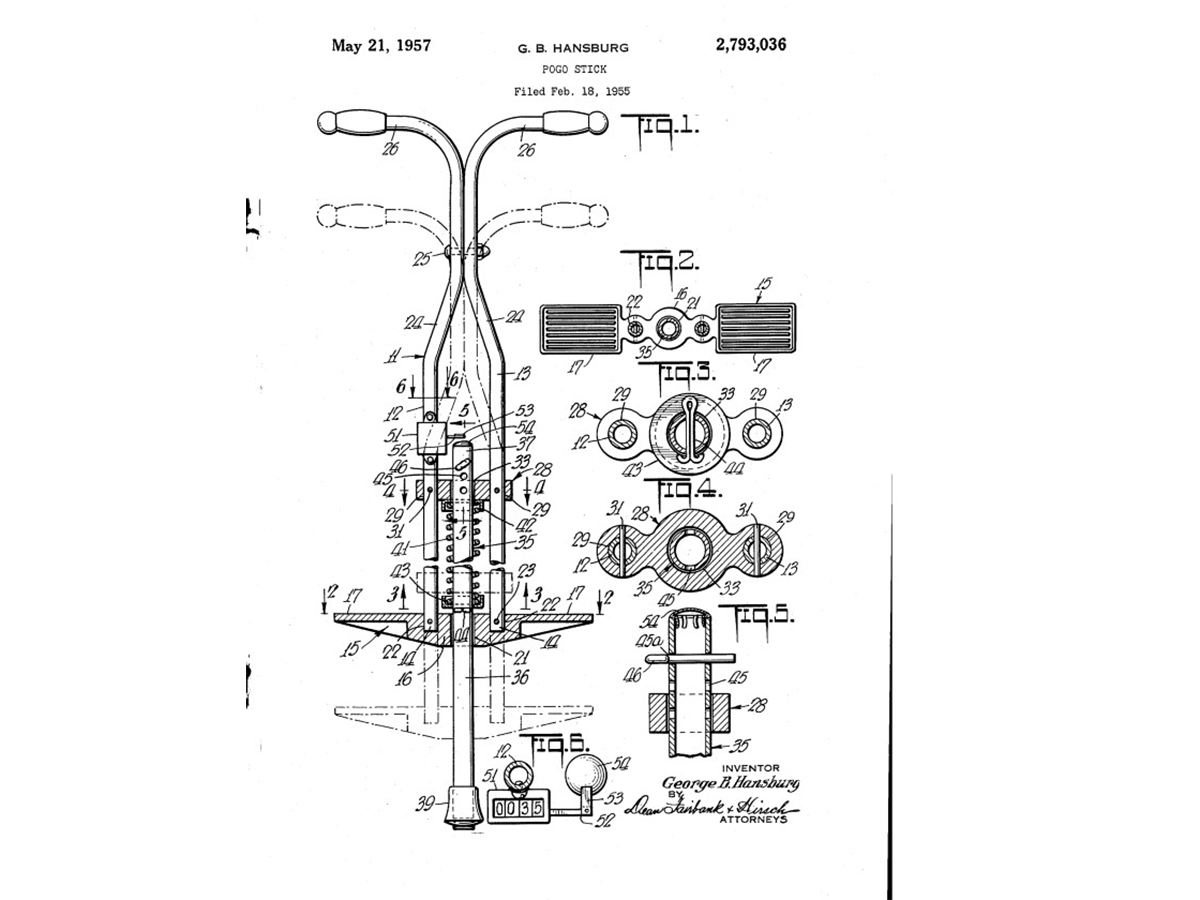 George Hansburg did not invent the pogo stick, but he helped improve it. This illustration of his patent from 1957 shows the horizontal handles that decreased incidences of facial injuries. / United States Patent and Trademark Office
George Hansburg did not invent the pogo stick, but he helped improve it. This illustration of his patent from 1957 shows the horizontal handles that decreased incidences of facial injuries. / United States Patent and Trademark Office
Adding Fuel to the Hopping Craze
The pogo sticks experienced a resurgence in the 1950s, becoming a favorite of the baby boom-era children hopping around suburban neighborhoods. It was during this time that Elwood, Indiana, farmer Gordon Spitzmesser had an idea: what if you added an engine?
Spitzmesser experimented with various designs, including combining the barrel of a grease gun with a piston from an old lawnmower and a Ford Model A spark coil. His son Edwin was his test jumper, trying out various fuel mixtures. Oxygen and acetylene resulted in intense jumps, but in the end, Spitzmesser settled on butane as the safest. In March 1960 Spitzmesser received a patent for a “Combustible Gas Powered Pogo Stick” which he called the “Pop Along.”
 Gordon Spitzmesser's 1960 patent that eventually became the basis for the Hop Rod. / United States Patent and Trademark Office
Gordon Spitzmesser's 1960 patent that eventually became the basis for the Hop Rod. / United States Patent and Trademark Office
In 1961 Spitzmesser and his son appeared on national television. Edwin hopped around while his father explained the mechanics behind his invention. Although Spitzmesser never pursued mass production of his “Pop Along,” his patent was eventually acquired by Chance Manufacturing Co. of Wichita, Kansas.
The Hop Rod Takes Off
By 1971, Chance Manufacturing - best known for amusement park rides - began developing their own version of Spitzmesser’s design. After a year of testing, they released the Hop Rod, a pogo stick with a one-cylinder, two-cycle engine. It could run for up to 30 minutes - or approximately 600 hops - on four ounces of gas, preferably their proprietary blend called "Pogo-Go,"and eight C batteries. The Hop Rod activated when the rider's weight compressed the piston into the cylinder and activated the spark plug that fired the engine, launching the rider into the air.
 Gordon Spitzmesser's 1960 patent that eventually became the basis for the Hop Rod. / THF803604
Gordon Spitzmesser's 1960 patent that eventually became the basis for the Hop Rod. / THF803604
Priced at around $70, the Hop Rod was marketed to parents and children, featured in commercials and local newspaper ads. Retailers across the country stocked the Hop Rod, including Young Diversified Industries in New Jersey and Midtown Cycles in Florida. Moto Pogo, Inc. in Vermont even offered a free electric popcorn maker (“Butterpopper”) with purchase in April 1973. The Hop Rod appeared at automobile shows, including the 17th Annual New York Automobile Show in New York City in April 1973. Newspaper articles of the time touted brisk sales, highlighting the Hop Rod as the hot Christmas gift in both 1972 and 1973.
 Gordon Spitzmesser's 1960 patent that eventually became the basis for the Hop Rod. / THF803610 (left),THF803607 (center), THF803611 (right)
Gordon Spitzmesser's 1960 patent that eventually became the basis for the Hop Rod. / THF803610 (left),THF803607 (center), THF803611 (right)
But the Hop Rod was a shooting star - fast and flashy but too dangerous. Each engine “pop” produced increasingly higher jumps, sometimes beyond what the rider could control. The engine engaged upon impact with the ground - regardless of whether the rider landed vertically or at an angle - making it easy to be flung sideways into trees or other obstacles. Injuries followed, and the new gadget shine quickly wore off. By 1975, sales slumped, and Chance Manufacturing discontinued the Hop Rod.
Modern-Day Hopping
Although fuel-powered pogo sticks have vanished, pogo technology continues to evolve. Today's models use compressed air or solid rubber tube technology to absorb and release energy, enabling higher jumps and extreme tricks. Whether low-tech or high-powered, the pogo stick keeps on hopping into the 21st century.
The Henry Ford’s Hop Rod was conserved, rehoused, and digitized thanks to a grant from the Institute of Museum and Library Services (IMLS).
Aimee Burpee is an Associate Curator at The Henry Ford.
George Balanchine and Ballet in America
If you are a fan of American ballet — be it regularly attending productions, seeing The Nutcracker at Christmas, or simply imagining what it would be like to be a prima ballerina — then you have likely engaged with the legacy of one of the dance world’s most important figures: George Balanchine.
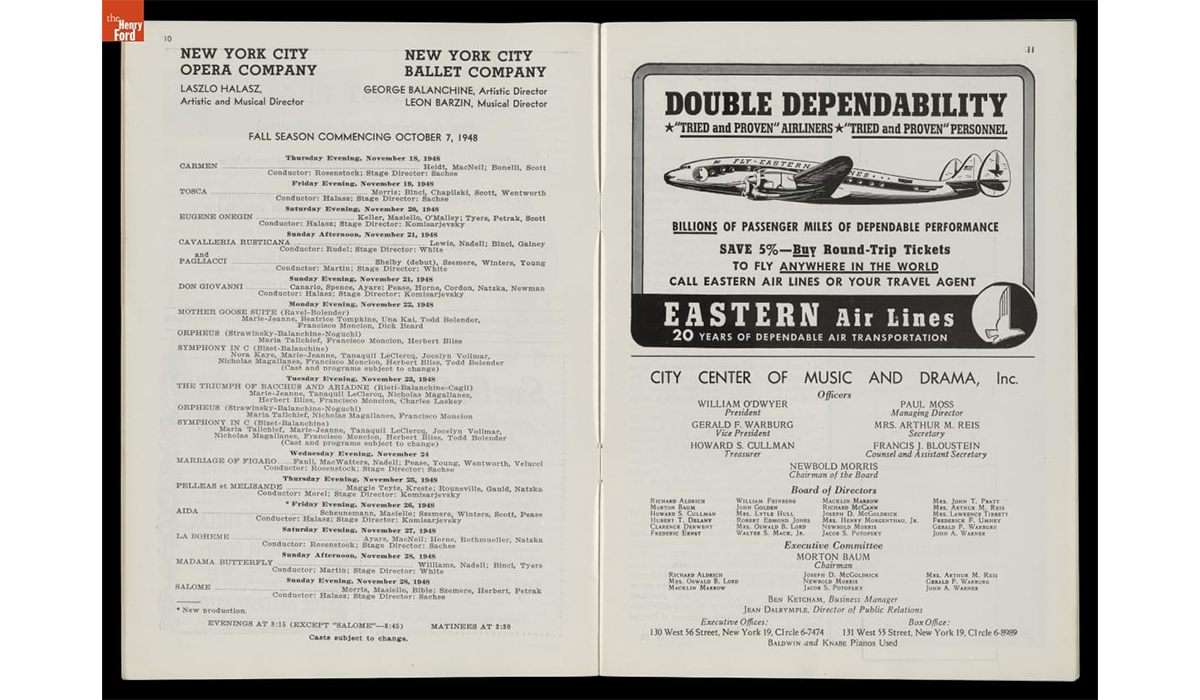 Program from New York City Center of Music and Drama, November 1948, featuring New York City Ballet’s schedule of Balanchine-choreographed performances / THF715566
Program from New York City Center of Music and Drama, November 1948, featuring New York City Ballet’s schedule of Balanchine-choreographed performances / THF715566
George Balanchine was born Georgiy Melitonovich Balanchivadze on January 22, 1904, in St. Petersburg, Russia. "He was exposed to the arts from birth, as his father was as his father was Meliton Balanchivadze, Georgian opera singer, composer, and founder of the Tbilisi Opera and Ballet Theatre. His Russian mother, Maria, was also a lover of ballet, and although she thought her son would eventually join the military, she insisted that he audition for dance. At age nine, Balanchivadze was accepted into the Imperial Ballet School at the Mariinsky Theatre. Throughout his early years at the school, Balanchivadze already started to work on his choreography. In 1920 he debuted his first piece — a duet, La Nuit, which was met with some disapproval from his school's directors.
 When Balanchine was born, ballet was seen as a way of rising through the ranks of St. Petersburg society. The city was the cultural center of Russia, and remained so throughout World War I (when it was renamed Petrograd) and after the October Revolution (when it was renamed Leningrad). / THF208535
When Balanchine was born, ballet was seen as a way of rising through the ranks of St. Petersburg society. The city was the cultural center of Russia, and remained so throughout World War I (when it was renamed Petrograd) and after the October Revolution (when it was renamed Leningrad). / THF208535
After graduating, Balanchivadze enrolled at the Petrograd Conservatory, and worked at the State Academic Theatre for Opera and Ballet in their corps de ballet, before forming his own ensemble, the Young Ballet. The Soviet government granted permission for the group to travel around Europe, and they eventually settled in Paris. In 1924, Balanchivadze was invited to join the famous Ballets Russes as the main choreographer, quickly being promoted to ballet master of the company. It was here that he changed his last name to Balanchine, and shifted his focus exclusively to choreography after a knee injury.
After the bankruptcy of Ballets Russes in 1929, Balanchine found work with other European companies, and continued creating new pieces. In 1933, American writer and cultural figure Lincoln Kirstein convinced Balanchine to move to New York City. With Kirstein’s support, Balanchine founded the School of American Ballet, opening its doors in 1934 with the aim of providing more rigorous training for American dancers. In 1948, Balanchine and Kirstein founded the New York City Ballet. It was for this company that Balanchine would create perhaps his best-known work - his version of The Nutcracker.
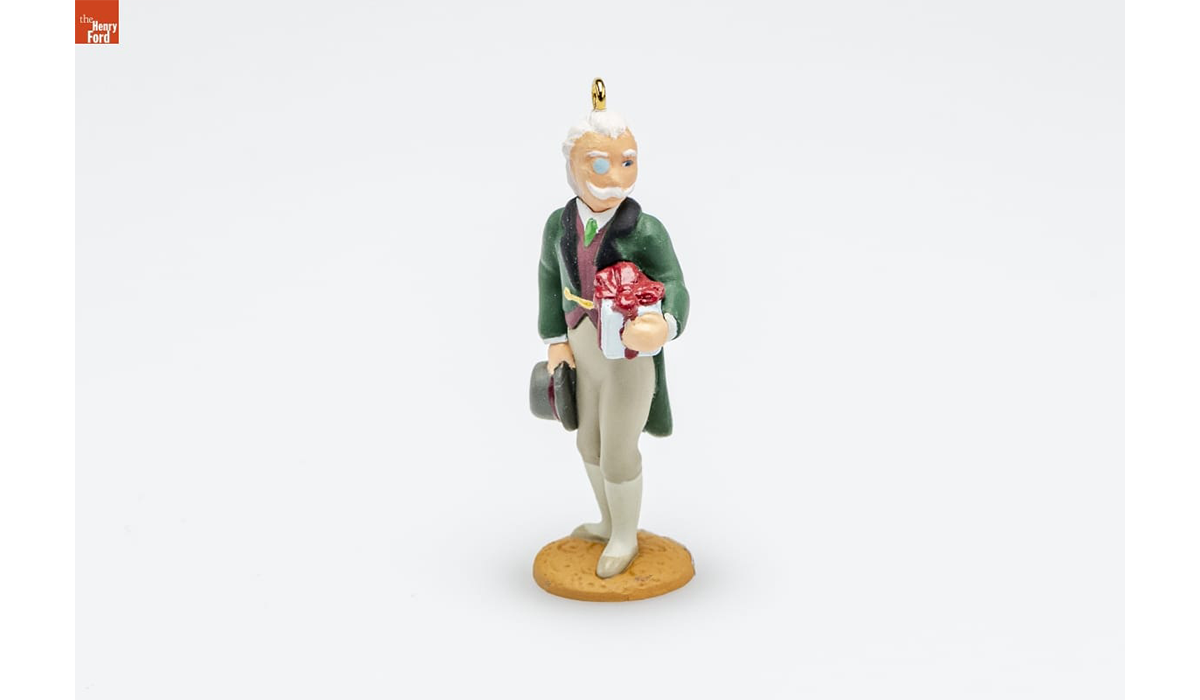 When Balanchine first created his version of The Nutcracker, he returned to the stage in the role of Herr Drosselmeyer. / THF360453
When Balanchine first created his version of The Nutcracker, he returned to the stage in the role of Herr Drosselmeyer. / THF360453
Although it was not the first version of The Nutcracker to be performed in America - that distinction goes to Willam Christensen's 1944 staging for the San Francisco Ballet — Balanchine's 1954 production helped cement the ballet's popularity, and indirectly ensured the survival of ballet in America. His version is distinct from others in that “Clara” is called “Marie” (her name in E.T.A. Hoffman's original story) and it maintains the tradition of casting children for the roles of Marie and Drosselmeyer's nephew (who is also The Nutcracker that becomes the Prince), rather than casting adult principal dancers as became common in other productions. Today, annual performances of The Nutcracker are what keep many American ballet companies afloat, with ticket sales for performances constituting approximately forty percent of their yearly revenue; it is Balanchine's version that remains the most popular staging.
 Famed dancer Maria Tallchief — the first major American prima ballerina, and a member of the Osage nation — was lauded for her role as the Sugar Plum Fairy in Balanchine’s production of The Nutcracker. She is often credited alongside Balanchine with revolutionizing American ballet. / Seen here at top right, THF715558
Famed dancer Maria Tallchief — the first major American prima ballerina, and a member of the Osage nation — was lauded for her role as the Sugar Plum Fairy in Balanchine’s production of The Nutcracker. She is often credited alongside Balanchine with revolutionizing American ballet. / Seen here at top right, THF715558
During his career, Balanchine founded several ballet schools, companies, and nonprofits. They include the previously mentioned School of American Ballet (1934-present) and New York City Ballet (1948-present), the American Ballet (1934-1938) which later joined with the American Ballet Caravan (1936-1941), and the Ballet Society (1946-present). Balanchine also served as the principal choreographer for Ballet Russe de Monte Carlo from 1944 to 1946.
In 1964, the Ford Foundation gifted almost $8 million to support professional ballet in America; nearly all of it went to Balanchine-affiliated companies. His choreographic work was prolific, as he created 400 individual works, many of which remain in the canon of ballet companies in America and abroad. He was also known for his choreography for Broadway and Hollywood productions, and for collaborating with the likes of composer Igor Stravinsky and designer Isamu Noguchi (who would continue working in the dance world by partnering with Martha Graham) for his productions.
 For the 1940 New York World’s Fair, Ford Motor Company hired American Ballet Caravan to perform A Thousand Times Neigh, a ballet telling the story of the automobile through the eyes of Dobbin the horse. The dancers had been trained at Balanchine’s American Ballet. /THF215723
For the 1940 New York World’s Fair, Ford Motor Company hired American Ballet Caravan to perform A Thousand Times Neigh, a ballet telling the story of the automobile through the eyes of Dobbin the horse. The dancers had been trained at Balanchine’s American Ballet. /THF215723
Balanchine’s impact on ballet in America is almost impossible to overstate. Writing for the New York Times after his death on April 30, 1983, Anna Kisselgoff called George Balanchine “one of the greatest choreographers in the history of ballet ... [who] established one of the foremost artistic enterprises the United States has called its own.” The Georgian immigrant became known as the father of American ballet, as his choice to move beyond the classical style of his original training created a distinctly American style, one that rejected classical models and instead embraced artistic expression and dance for its own artistic and athletic sake, rather than as just a storytelling medium. This focus on athleticism and aesthetics, though, did not come without cost. Through his prolific work, Balanchine’s ideal dancer — long-legged and extremely thin — became the standard for American ballet. The pressure for ballerinas to be almost preternaturally thin persists to this day, and eating disorders and body dysmorphia are sadly not uncommon.
The story of American ballet — for better and for worse — is in so many ways the story of George Balanchine.
Rachel Yerke-Osgood is an Associate Curator at The Henry Ford.
Youth Inventors Invent Sustainable Solutions to Global Challenges
Through The Henry Ford's Invention Convention Worldwide program, K-12 students identify a problem and work through the invention process to design a solution for it, and have the opportunity to present their inventions at local, state and regional competitions. While projects and topics vary, many inventors seek to tackle some of the most complex global challenges of our time, like climate action, cybersecurity, water scarcity and infectious disease.
At the culminating RTX Invention Convention U.S. Nationals competition, the top youth inventors from across the country pitch their inventions to judges and compete for awards and cash prizes.
 Group photo from RTX Invention Convention U.S. Nationals 2025. Image courtesy of The Henry Ford’s Senior Photographer Jillian Ferraiuolo.
Group photo from RTX Invention Convention U.S. Nationals 2025. Image courtesy of The Henry Ford’s Senior Photographer Jillian Ferraiuolo.
What makes Invention Convention unique is that students identify the problem they wish to solve, providing for autonomy and greater engagement as they're solving problems they care about. Many look at the world around them and find they have potential solutions for sustainability problems that affect their home, their community or even the world at large. Here's a look at some of the award-winning inventions related to sustainability from this year's event:
- Incredapack, invented by Gwen Livingood, is a six-pack ring made from kelp that is meant to be a biodegradable solution to plastic six-pack rings polluting our oceans. For this invention, Gwen earned 2nd place in the 5th grade as well as the Environment and Sustainability Award, presented by the Avangrid Foundation.
- GroundLock - Preventing Agricultural Soil Erosion, invented by Grant Richmond, Zander Yang, Ashon Carter and Ravinath Boulton, is an innovative way to capture precipitation to redirect and store water on agricultural lands to prevent soil erosion. For their efforts, this Michigan team earned a Patent Application Award, presented by Cooley LLP.
- Reel Green Tackle, invented by Ian Klimowicz, is a biodegradable fishing lure and bobber that combats the effects of plastic fishing equipment that causes harm to wildlife and the environment. For this invention, Ian earned 3rd place in the 6th grade.
- ClearCrete, a Concrete Water Filter for Roadways, invented by Stepan Mkrtchian, provides a long-lasting, low-maintenance and effective water purification solution with applications in both urban and rural settings. This invention earned Stepan a Patent Application Award, presented by WilmerHale.
 Gwen Livingood accepts the Environment and Sustainability Award, presented by the Avangrid Foundation, for her invention Incredapack. Photo by Nick Hagen.
Gwen Livingood accepts the Environment and Sustainability Award, presented by the Avangrid Foundation, for her invention Incredapack. Photo by Nick Hagen.
 The team of Zander Yang, Ravinath Boulton, Ashon Carter and Grant Richmond accept their Patent Application Award, presented by Cooley, for their invention GroundLock. Photos by Nick Hagen.
The team of Zander Yang, Ravinath Boulton, Ashon Carter and Grant Richmond accept their Patent Application Award, presented by Cooley, for their invention GroundLock. Photos by Nick Hagen.
In addition to these projects, other sustainability-related inventions included:
- A biodegradable tennis ball to reduce the number of tennis balls that end up in landfills;
- Several inventions designed to help clean up trash from the beach;
- A robotic dog that would use AI sensors that would use AI sensors to detect and remove trash from hard-to-reach areas like forests, shallow canals etc.;
- A sustainable solution for removing oil from water using cactus powder;
- An artificial base for coral made out of eggshells to prevent further ocean acidification and global warming;
- And a device that would enable consumers to reuse scraps of paper, which doubles as a compactor and composter.
Invention Convention instills problem-identification, problem-solving, creativity and entrepreneurship skills for life, empowering students to become the inventors, innovators and entrepreneurs of tomorrow. We are continuously filled with hope for our future with these incredible inventors leading the way and we’re thrilled to see so many youth focused on projects that will help our environment.
 All award-winners from RTX Invention Convention U.S. Nationals posing with RTX staff members and Aisha Bowe. All winners received a LINGO STEM kit created by Aisha and her team.
All award-winners from RTX Invention Convention U.S. Nationals posing with RTX staff members and Aisha Bowe. All winners received a LINGO STEM kit created by Aisha and her team.
To see a full winners list from RTX Invention Convention U.S. Nationals, click here.
To learn more about Invention Convention, please visit inventionconvention.org.
Samantha Rhoads, inHub Marketing Specialist
Stories of Long-Distance Human Voice Transmission
Objects and their histories can sometimes be inadvertently separated or lost — especially in long-lived institutions and museums. Recently, staff at The Henry Ford rediscovered a simple, unassuming object with its history literally attached to it — a history that pointed to early voice transmission. A history once lost that had to be pieced together again, some one hundred years later. Research connected with this object is an ongoing rediscovery to present a story of invention, innovation, and resourcefulness.
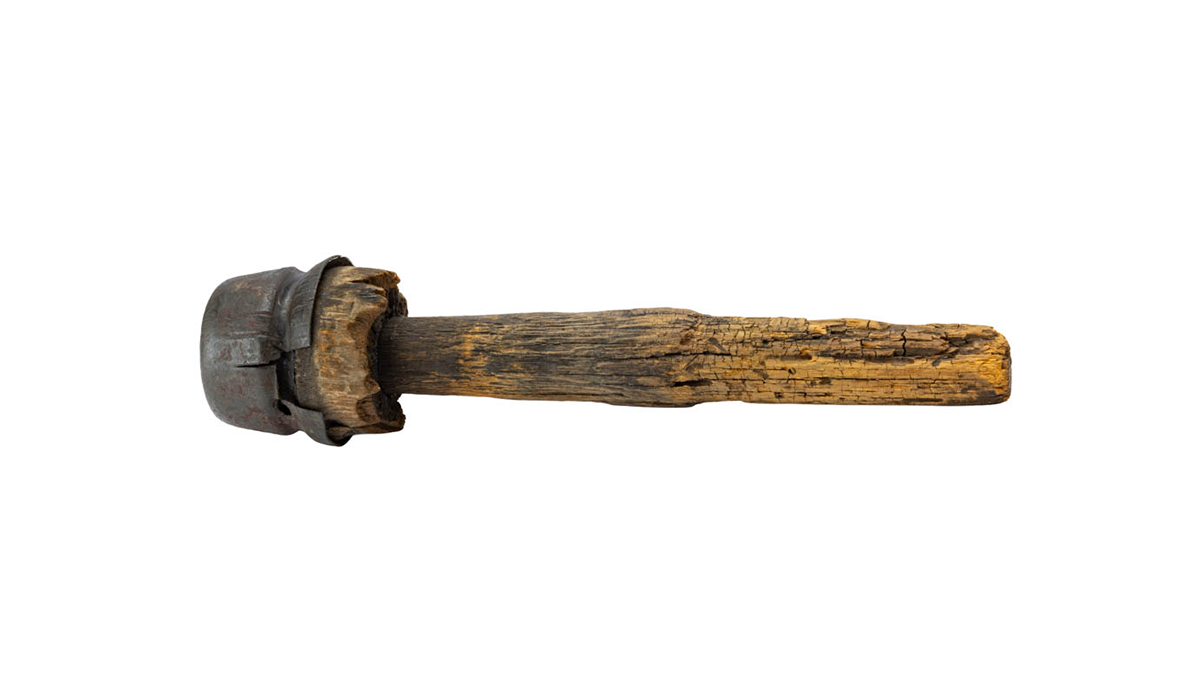 A telephone insulator with possible links to early voice transmission experiments. / THF805303
A telephone insulator with possible links to early voice transmission experiments. / THF805303
The Object
The object is a piece of wood, a little over ten inches long, with a metal cap around a shaped end. Staff found this club-like object as part of our 2024–2026 IMLS grant project (a two-year federally funded grant to clean, rehouse, and create digital records for artifacts related to power and energy, mobility and transportation, and communications and information technology). It was found in a storage box with other unassociated communications bits and pieces — unnumbered. The object looked like an early telegraph insulator, which had been around for decades before the invention of telephone. However, an attached tag specified a "Telephone Insulator." Also, this insulator is not much to look at, and it easily could have been disregarded as an unremarkable communication insulator and bracket — reminiscent of other objects in The Henry Ford's collection.
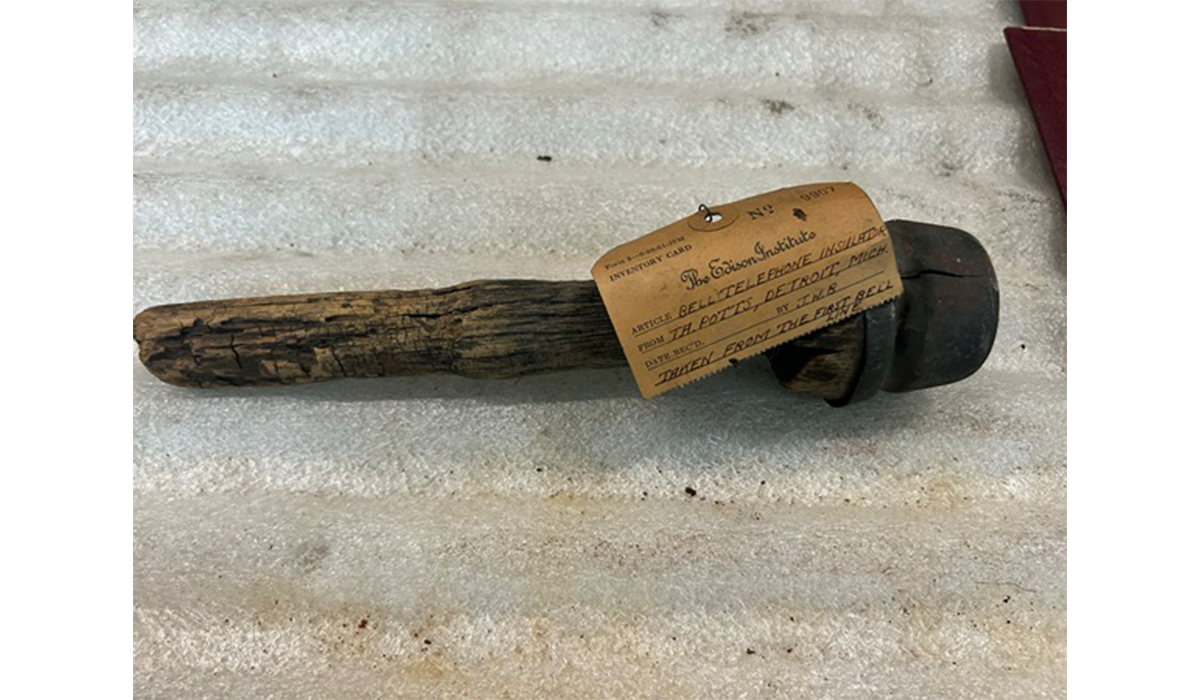 The telephone insulator soon after it was found with the letter and map/drawing removed. Photo by Colleen Sikorski.
The telephone insulator soon after it was found with the letter and map/drawing removed. Photo by Colleen Sikorski.
But something set this object apart from the rest. It had information, usually found in museum files, wrapped around the bracket body: an old Edison Institute tag and two pieces of paper with a map. After reading the tag and unrolling the pages to find the original donation letter and a hand-drawn map, our staff recognized that this object held more significance than once believed. This piece of wood possibly had a connection to Alexander Graham Bell, early voice transmission, and the invention of the telephone.
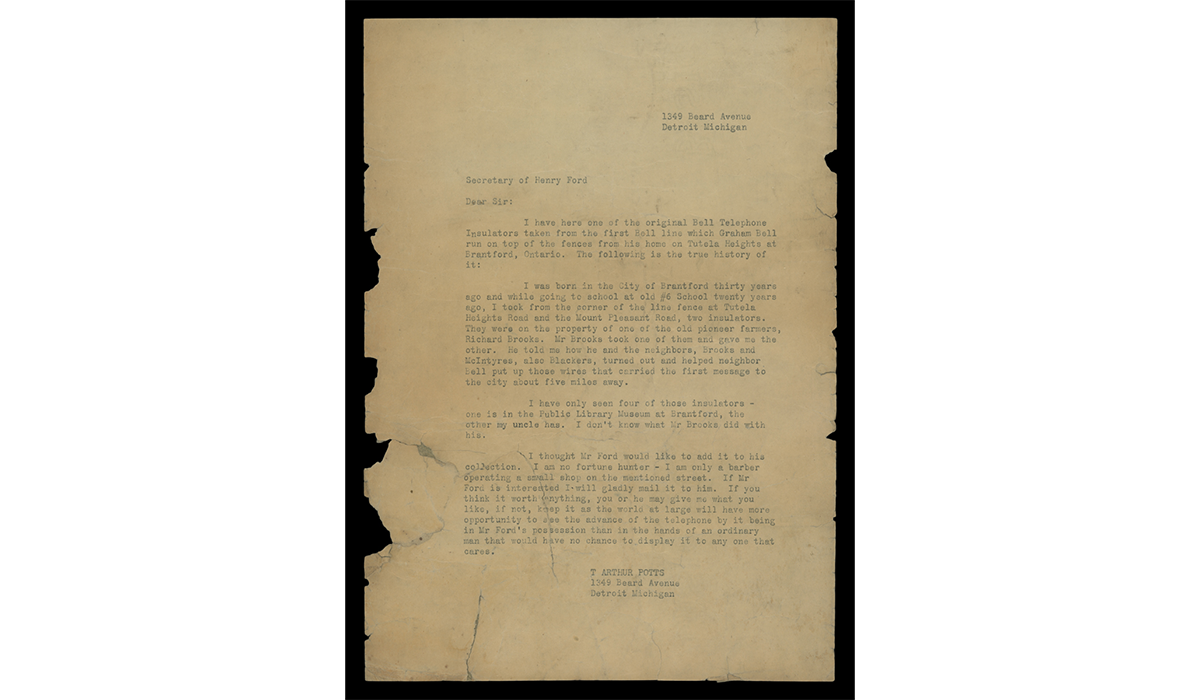 Typed letter from Thomas Potts to the secretary of Henry Ford. / THF727164
Typed letter from Thomas Potts to the secretary of Henry Ford. / THF727164
The Story Attached
The Edison Institute tag contained a somewhat cryptic message: this object was a "Bell telephone insulator … taken from the first Bell line," but there was no explanation of what the "first Bell line" was. The attached letters and map provided more information and posed additional questions. The donor, T. Arthur Potts, wrote to the secretary of Henry Ford, offering Ford one of the "original Bell Telephone Insulators taken from the first Bell line which Graham Bell run [sic] on top of the fences from his home on Tutela Heights at Brantford, Ontario." If true, the object was not simply an ordinary insulator but one connected to Alexander Graham Bell and the early history of the telephone.
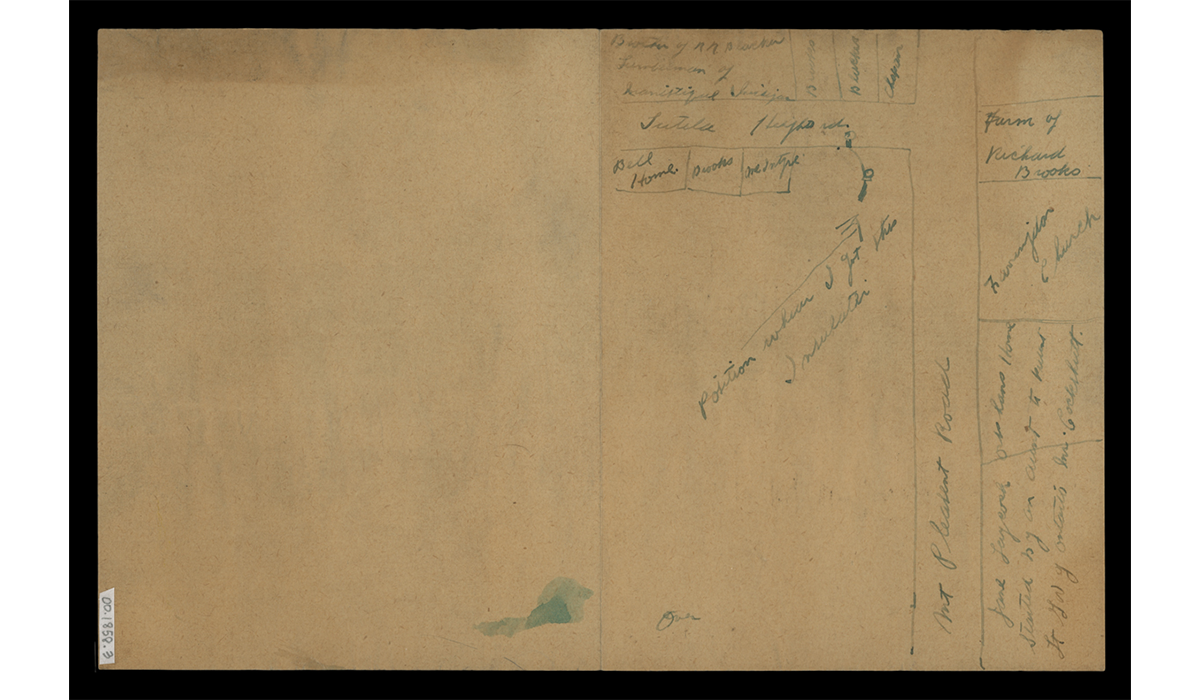 "Thomas Potts' hand drawn map. / THF727167
"Thomas Potts' hand drawn map. / THF727167
Mr. Potts then related how he acquired the insulator (where it was found and what happened to the other recovered insulators) and offered this one to Henry Ford. Potts added a hand-drawn map (noting the location of Bell's home and Bell's neighbors and indicating the insulator's initial location) and provided a drawing of the insulator on a separate page.
At face value, this is an intriguing story. But as many historians understand, some stories do not live up to their histories. There may be truth in this unsubstantiated story, or it may be just that — a story. As curators, we began to piece back together the history — one hundred years lost.
A History Uncovered
The undated letter provided a starting point. In it, T. Arthur Potts mentioned he was born in Brantford, Ontario, "thirty years ago," and that he received the insulator "twenty years ago." But when was that? The tag on the insulator came from the Edison Institute (established in 1929), but Henry Ford had been collecting before that. The letter could date from 1920 up into the mid-to-late 1930s. Genealogy research provided some answers.
According to census and other records, Thomas Arthur Potts was born in 1896 in Brantford, Ontario. Other documents reveal that Potts emigrated to the United States at the end of 1923; he then shows up in the 1924–1925 Polk's Detroit city directory living at the address indicated in the letter. This information places the letter sometime in the mid-1920s. Potts, then, would have received the insulator about 1906.
But is there a connection to Alexander Graham Bell and the early history of the telephone? My understanding of the invention of the telephone was limited. I knew Bell received the first patent for the telephone, but I thought he made the first "call" somewhere in the United States. Potts lived in Canada and mentioned that the insulator was "from the first Bell line." Through some quick online searches, I found references to the "first long-distance" phone call made from Brantford to Paris (Ontario) on August 10, 1876 (months after Bell's call to his assistant Thomas Watson on May 6, 1876, in Boston, Massachusetts). Could this insulator have something to do with the supposed "first long-distance" phone call? Reading more about Alexander Graham Bell and the history of the telephone, then contacting other experts, provided more answers.
 Alexander Graham Bell. / THF253967
Alexander Graham Bell. / THF253967
Alexander Graham Bell's family lived on Tutela Heights Road near Brantford, Ontario. The home is now the Bell Homestead National Historic Site. When the question of whether this insulator could be associated with that historic "first long-distance" phone call, the Bell Homestead curator doubted the connection. This one-way, "long-distance" call, with the transmitter in Brantford and the receiver in Paris, Ontario, used the existing telegraph lines that already had insulators — and certainly not like the one that The Henry Ford had. And through other research I discovered that the first long-distance two-way call where people could receive and transmit voice messages happened a few months later in October 1876, between Boston and Cambridge, Massachusetts, far from where Mr. Potts had resided. Was this a dead end? Was it time to move on? Was this just an object with a story — a lost history? It appeared so.
A few last-minute searches proved fortuitous. The famed "long-distance call" from Brantford to Paris, Ontario, happened in August 1876 and was made over existing telegraph lines. I did not yet fully realize that Alexander Graham Bell conducted other voice transmission experiments at the same time until I saw a copy of Bell's address at the unveiling of the Bell Memorial in Brantford in 1917. In the speech, Bell mentioned "[t]here were also other experiments that some of the older residents of Brantford may remember, in which the receiving instrument was placed on the porch of my father's house at Tutela Heights…" He continued: "… we got stove-pipe wire in Brantford… and tacked it along the fences from the corner of the Mount Pleasant Road to Tutela Heights - and it worked." Was it possible that this telephone insulator donated by Potts was part of these additional experiments?
Another source provided further confirmation. In the 1926 publication, Pioneering the Telephone in Canada, William Patten related the same story and added key pieces of information that meshed with the Potts letter. Patten wrote that Bell made notes of these experiments, and when "[s]peaking at the annual banquet of the Brantford Board of Trade in 1906 … Dr. Bell said that his memory had come back very clearly to him, in driving out to his father's old homestead at Tutelo [Tutela] Heights, and on his way there he was pleased and proud to meet the two men who had helped him put up the first telephone line in Canada, Mr. McIntyre and Mr. Brooks." (p. 16) These were two of the three names mentioned in the letter by Thomas Potts. And the 1906 date is telling. That was around the time when Thomas Potts states he received this insulator as a ten-year-old boy. Was Potts there when the three old neighbors met, and did he listen to their reminiscences? For a young boy, this would have been a memorable event, to see and hear from Brantford's renowned inventor and one-time resident. Unfortunately, Potts' letter is silent on whether this occurred, only that he received this insulator around that time.
Yet, even with more questions, we have a link to the August 1876 experiments by Alexander Graham Bell to refine his invention that linked friends and families together — not with the taps and clicks of a telegraph key, but the sounds of their own voices — an initial step to communicate across town, city, country, and the world.
Story or History
A telephone insulator wrapped with an old, undated letter could easily have been overlooked and its history disregarded. However, deciphering the clues found in bits of human memory has begun to restore its once-lost history. Piecing together the information — placing people and names in context, asking the right questions, and learning from knowledgeable sources and colleagues — may not reveal its complete history, as some things remain hidden. But even what we have already uncovered can help us tell fuller stories. How complexities of human memory mesh with stories of invention, innovation, and resourcefulness run through wire strung along a fence line attached to an unassuming piece of wood to bring human voice transmission to the world, transforming communication.
Sources consulted in this (re)discovery of the history of the telephone insulator, include:
Brantford Public Library and the Brant County Board of Education. Brantford Honours Alexander Graham Bell, 1874-1974. (Brantford, Ontario): Brantford Public Library and the Brant County Board of Education, 1974.
Bruce, Robert V., Alexander Graham Bell and the Conquest of Solitude. Ithaca and London: Cornell University Press, 1990 [1973].
Patten, William. Pioneering the Telephone in Canada. Montreal: Privately Printed, 1906.
Andy Stupperich is an Associate Curator at The Henry Ford.
The following article shares highlights from the collections of The Henry Ford to illustrate work undertaken by female Red Cross volunteers during World War II. More than three million women repaired and drove vehicles as part of the motor corps, cared for wounded service members in military hospitals, operated blood banks or operated canteens overseas, among numerous other tasks. The collections included here can help us to understand the role of women in the American Red Cross during wartime.

Join American Red Cross poster, 1942. / THF289755
The poster above conveys the centrality of women to the U.S. military response during World War II. The Red Cross, a non-governmental organization, “always stands by as friend to the service man” (Redlands [California] Daily Facts, 12 November 1941). The illustrator, Robert C. Kauffmann, emphasized the Red Cross nurse in other colorful posters during this time—aimed at recruiting nurses, field directors and hospital recreation workers. Sometimes he contextualized the nurses’ work in domestic flood relief, sometimes in war relief, but always with the message to “join.”
Women’s Motor Corps
Comparable service during World War I set a precedent. The American Red Cross Women’s Motor Corps began in 1917 and included women volunteers who transported the sick and wounded in ambulances.

Red Cross training using Ford Model T ambulances at the Highland Park Plant, July 1918. / THF130013
The American Red Cross, as a non-profit organization, depended on volunteers and charitable donations to meet need. During World War I, membership increased from 17,000 to over 30 million adults and older children. Contributions amounted to over $400 million in money and supplies. Ford Motor Company contributed $500,000 during the early years of World War I. The Red Cross turned around and used those funds to purchase Ford vehicles, nearly 1,000 of them, including 107 ambulances, for wartime use through the Motor Corps. Newspapers helped promote this work especially to young readers, as the following colorful cutout of a Ford ambulance represents.

World War I Red Cross Ambulance Cut-Out Paper Toy, December 9, 1917. / THF342142
Soon after war erupted in Europe in August 1939, urgent requests from the Red Cross began to reach wealthy Americans. Edsel Ford indicated his intention in May 1940 to support the fund drive required to meet the unprecedented need for assistance in war-torn Europe. He sent a postal telegram to W. J. Scripps of WWJ radio explaining that “Detroit’s share of the proposed relief fund can be raised only by the generous cooperation and support of everyone.”
Ford Motor Company maintained its support of the Women's Motor Corps during World War II as 45,000 drivers filled the Corps' ranks. This included African American chapters in some cities. The volunteers logged over 61 million miles ferrying Red Cross staff and supplies, couriering packages and messages, and occasionally assisting with Army and Navy transportation needs.

American Red Cross Women's Motor Corps members becoming familiar with engines during an auto maintenance class, Ford Motor Company, November 1941. / THF270093
Keeping the vehicles on the road required expertise. In 1941, Ford Motor Company began to provide automobile maintenance classes for the local Women’s Motor Corps at its Highland Park facilities. Instructors trained the volunteers in the mechanical skills they needed to keep their vehicles moving in times of emergency.

American Red Cross Women's Motor Corps members looking under the hood of a Ford ambulance, June 1942. / THF265816
Ford Motor Company donated its 29 millionth Ford automobile to the cause. The Super DeLuxe station wagon rolled off the Rouge Plant assembly line in April 1941. Edsel Ford presented this vehicle to the Detroit chapter of the American Red Cross for use by the volunteers of the Women’s Motor Corps.

The 29 Millionth Ford and a driver from the Detroit chapter of the American Red Cross Women's Motor Corps, April 29, 1941. / THF270147
Workwear for Health Care
The American Red Cross hired trained nurses to assist doctors treating service men. Gray ladies nurse's aides provided an additional layer of volunteer support in military hospitals and boosted the morale of patients. They all wore the distinctive red cross emblem on their uniforms, adopted at the 1864 Geneva Convention to designate medical personnel during wartime. Active-duty Red Cross nurses wore plain white uniforms with bishop collars and caps and a dark blue cape lined in red during wartime, which was standard issue throughout World War II. As of December 24, 1915, active-duty nurses stationed abroad wore gray cotton crepe dresses with a white pique collar and cuffs, cap, and brassard. Public health nurses wore gray chambray. Uniform regulations decreed that the red cross appear prominently on the front of the cap, brassard, and nurse’s cape.

World War I era poster depicting the uniform of a Red Cross public health nurse, 1917. / THF112608
The Gray Lady Service also tended to soldiers in non-medical capacities during and between wars. They wrote letters, delivered bandages, or served snacks to men who needed physical and emotional comfort.

Gray Lady Service uniform, 1940-1945 (left). / THF173341; Gray Lady Service uniform, 1955 (right). / THF94383
The indoor uniform of the Gray Lady Service consisted of a gray cotton dress with detachable white collar and cuffs, a two-inch woven red cross on the upper pocket, and white epaulets worn on each shoulder. The red bars and chevrons worn on the sleeves conveyed length of service (Shirley Powers, “A Guide to American Red Cross Uniforms,” 2nd ed., 2006).

American Red Cross Volunteer Nurse's Aides, Peoria, Illinois, May 20, 1942. / THF289753
The American Red Cross and the U.S. Office of Civilian Defense specified details of the volunteer nurse’s aide uniform in November 1942. It consisted of a blue jumper-apron worn over a regulation white poplin blouse. Nurse’s aides donned the uniform after the first 34 hours of training, and the cap after completion of the 80-hour course. The full uniform included a three-inch joint Red Cross and Office of Civilian Defense nurse’s aide emblem, sewn on the upper left sleeve of the blouse, two inches below the shoulder seam. Chapters could recognize hours of service by awarding white stripes but only for those volunteering in hospital wards, in clinics, and in health agencies qualified for these.
National Blood Donor Service
The American Red Cross began its National Blood Donor Service for the U.S. military in February 1941. Volunteers worked in the new blood banks, collecting blood and plasma donations and shipping them to hospitals caring for soldiers wounded in battle.

25,000th Blood Donor at the Ford Rouge Plant Pressed Steel Building, May 1943. / THF290075
Women working at Willow Run had their first chance to donate blood to the National Blood Donor Service in November 1944. The Ford Motor Company built its Willow Run Bomber Plant in 1941. Approximately one-third of the labor force were women. They performed office work but also drafted designs and worked on the assembly line, riveting and welding B-24 bomber components. At the plant's peak in 1944, Willow Run crews produced an average of one bomber every 63 minutes.

A Red Cross nurse draws blood from a female Ford Motor Company employee at Willow Run Bomber Plant, November 27, 1944. / THF728198
Canteen Girls and Donut Dollies
The female Red Cross volunteers who faced some of the most dangerous situations during World War II included those who served overseas as Canteen Girls or Donut Dollies. This work began during World War I in service to soldiers on the move, as a 1918 photograph of an African American woman in Detroit, handing bananas to soldiers indicates. During World War II, women traveled in mobile club wagons that often operated close to intense fighting. Critics claimed that the young women, all college educated and carefully selected, assumed significant personal risk. Julia Ramsey, author of “’Girls’ in Name Only” (Auburn University, 2011), claims that these women had access to battle and combat that no civilian women had previously. Paige Gulley, author of “After All, who takes care of the Red Cross’s morale?” (Chapman University, 2021), analyzed primary source created by the volunteers themselves to explain how women relied on each other to manage stress and meet expectations.
These examples represent the breadth of service and due diligence that female volunteers provided to the American Red Cross. The organization was not perfect and need often exceeded the capacity of staff and volunteers to meet it. The opportunity to work for humanitarian causes drew women who wanted to do something to support the U.S. cause during World War II. In addition to the options described above, women pursued other outlets through the Red Cross that relieved stress for individuals and families in crisis.
Debra A. Reid, Curator, Agriculture and the Environment, with Matt Anderson, Curator of Transportation, and Jeanine Head Miller, Curator of Domestic Life, The Henry Ford
Draft by Draft: The Making of The House by the Side of the Road

Richie Jean Sherrod Jackson at desk. / Photo feature in Black Belt Living, April 2012
Before starting my role as the Processing Archivist for the Jackson Home in 2024 — which would soon find me processing the papers, photographs, and other 2D materials of the Jackson family — I sought out an accessible entry point to serve as my introduction. In the weeks before my start date, I turned to Richie Jean Sherrod Jackson’s memoir, The House by the Side of the Road: The Selma Civil Rights Movement. A swift, engaging read, the book is approachable and informative, detailing Richie Jean's diverse experiences of her upbringing in both the South and the nation’s capital before settling back in Selma, Alabama, and raising a family. Interwoven with her and her family’s personal narratives are stories of the national figures we know and recognize, portraying their individual personalities as well as highlighting the critical roles they played in the Movement as the events of 1965 unfolded in Alabama and across the country.
After reading such an intimate, impactful account, it should not have come as a surprise to me when I began parsing through her papers that Richie Jean had saved so many of her previous drafts. Across some 30 documents, Richie Jean preserved not only the Jacksons’ experience of the events leading up to the 1965 Voting Rights Act, but much of the materials showcasing her writing process as well. As I pored over the collection, I was struck by the ease with which her handwritten notes and outlines flowed into typed drafts with edits in a familiar red pen – a hallmark of many a teacher not to be missed by this lifelong educator.

A section of Richie Jean’s favorite poem, Sam Walter Foss’s “The House by the Side of the Road,” intercut with her own verses. / Photo by Staff of The Henry Ford
In dating these documents, we can see that decades passed before the Jacksons began to consider how they would tell their story. One of their earliest creative explorations centers on the 1897 poem for which the book was eventually named: “The House by the Side of the Road” by American poet and librarian, Sam Walter Foss. Here, Richie Jean penned new lines, providing geographic specificity to replace the piece's vaguer verses — lines that better represent her home and the hospitality she provided.

Richie Jean’s draft for a movie or television program based on her life story, 1997. / Photo by Staff of The Henry Ford
Another instance included a premise, structure, and storyline on Richie Jean’s life were it to be adapted for a TV program or movie, featuring a motif of an empty basket slowly filled with ribbons — collecting a ribbon for each influential figure in her life.
But by 1997, we find the project would take its final form as a book, capturing the history of what went on in their home. Richie Jean wrote out details for events and key figures on dozens of subject notecards as the memories of that time came back to her. Text from these notecards often made its way verbatim into early drafts, as she organized her thoughts into one cohesive narrative. It’s from this point that we see the largest leap in time between materials — the manuscripts jump ahead by a decade from 1999 to 2009 before a date is noted again on a draft.
Richie Jean kept copies of all print and email correspondence with her publisher, the University of Alabama Press, beginning in 2007, when she shared her latest manuscript for their consideration. In 2008, the editing process began in earnest, and drafts were tweaked and trimmed as additional perspectives weighed in. Most of the manuscripts in the collection are from this period — roughly 2008 to 2010—as edited drafts were shipped back and forth between their offices in Tuscaloosa and the Jackson home in Selma. Drafts would implement styling changes for consistency, swap one turn of phrase for another, and eventually plug in the final pieces of front matter: title page, table of contents, dedication, acknowledgements, and copyright.

The opening chapter of The House by the Side of the Road, with text remaining consistent from its original handwritten notecard, to an early typed manuscript page, and the final manuscript. / Photo by Staff of The Henry Ford.
The publication of The House by the Side of the Road in 2011 was the culmination of years of effort. So what drove Richie Jean to write it?
The Jacksons had been interviewed many times over the years on their role hosting leaders of the Movement in Selma, but they never sought to leverage those relationships into positioning themselves as leaders and activists. It was only as they saw more and more inconsistencies across other retellings of the history they lived that they were prompted to share their own firsthand account. The cover of The House by the Side of the Road, featuring a photo of daughter Jawana Jackson sitting on the lap of Martin Luther King Jr., made their perspective on the matter abundantly clear — to them, “Uncle Martin” was a friend of the family first, and a national figure second.

The 2015 paperback edition of The House by the Side of the Road alongside the 1965 image featured on its cover of Jawana Jackson and Dr. Martin Luther King Jr. / Photo by Staff of The Henry Ford.
The Jackson family’s story shines a spotlight on ordinary people playing a small role in extraordinary moments in history and reminds us of the impact we all can have as well. As Richie Jean writes, “We cannot all be a Martin Luther King Jr., but each and every one of us can make a positive difference in the lives of our families and the people we meet each day. For you see the dream is still alive.”
Jack Schmitt is a Processing Archivist at The Henry Ford.

